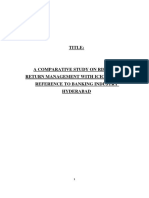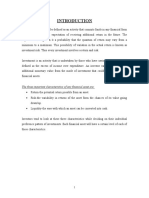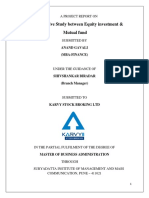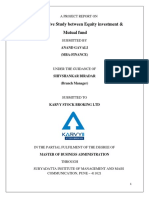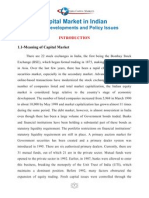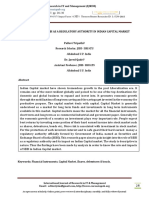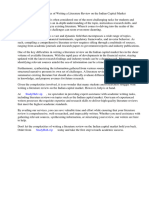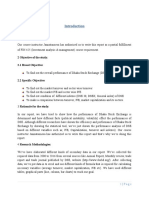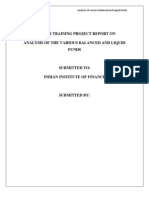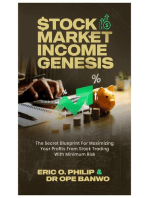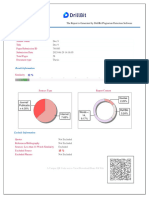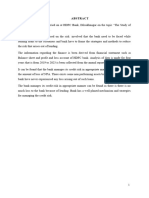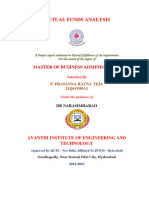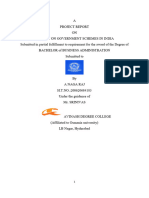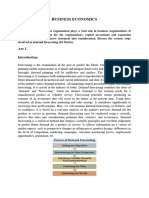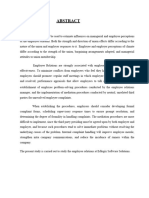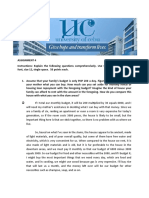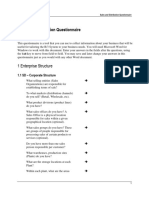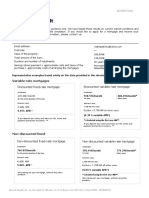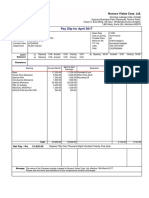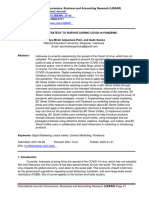New Auto & Oil Project
Uploaded by
Rajesh BathulaNew Auto & Oil Project
Uploaded by
Rajesh BathulaCHAPTER- I
INTRODUCTION
1
INTRODUCTION
In today’s fast developing Indian economy, among the various financial
institutions, the share market has become a major source of investment for every category
of investors ranging from big institutional investors to small individual investor.
Unlike earlier days when common man used to invest his savings in less risky and
well trusted financial institutions and instruments like public and private sector Banks,
Government Bonds and policies etc., today’s investors have realized that stock market is
a crucial source of earning quicker and higher returns on their investments as compared
to the returns earned in traditional investment methods.
EQUITY MARKET
In financial markets, stock is the capital raised by a corporation through the
issuance and distribution of shares. A person or organization which holds shares of stocks
is called a shareholder. The aggregate value of a corporation's issued shares is its market
capitalization. When one buys a share of a company he becomes a shareholder in that
company. Shares are also known as Equities. Equities have the potential to increase in
value over time. It also provides the portfolio with the growth necessary to reach the
long-term investment goals. Research studies have proved that the equities have
outperformed than most other forms of investments in the long term. Equities are
considered the most challenging and the rewarding, when compared to other investment
options. Research studies have proved that investments in some shares with a longer
tenure of investment have yielded far superior returns than any other investment.
However, this does not mean all equity investments would guarantee similar high returns.
Equities are high-risk investments. One needs to study them carefully before investing.
Since 1990 till date, Indian stock market has returned about 17% to investors on an
average in terms of increase in share prices or capital appreciation annually. Besides that
on average stocks have paid 1.5 % dividend annually. Dividend is a percentage of the
face value of a share that a company returns to its shareholders from its annual profits.
Compared to most other forms of investments, investing in equity shares offers the
2
highest rate of return, if invested over a longer duration. The first company to issue shares
of stock was the Dutch East India Company, in 1602. The innovation of joint ownership
made a great deal of Europe's economic growth possible following the Middle Ages. The
technique of pooling capital to finance the building of ships, for example, made the
Netherlands a maritime superpower. Before adoption of the joint-stock corporation, an
expensive venture such as the building of a merchant ship could only be undertaken by
governments or by very wealthy individuals or families. Equity markets, the world over,
grew at a great speed in the decade of the nineties. After the bear markets of the late
eighties, the world markets saw one of the largest ever bull markets of more than ten
years. The opening up of Indian economy in the 1990's led to a series of financial sector
reforms, prominent being the capital market reforms. These reforms have led to the
development of the Indian equity markets to t standards of the major global equity
markets. All this started with the abolition of Controller of Capital Issues and subsequent
free pricing of shares. The introduction of dematerialization of shares, leading to faster
and cheaper transactions and introduction of derivative products and compulsory rolling
settlement has followed subsequently. Despite a series of stock market scams and crises
beginning from 1992 Harshad Mehta's scam to the Ketan Parekh's 2001 scam, the Indian
equity markets have transformed themselves from a broker dominated market to a mass
market. The introduction of online trading has given a much-needed impetus to the Indian
equity markets. However, over the years, reforms in the equity markets have brought the
country on par with many developed markets on several counts. Today, India boasts of a
variety of products, including stock futures, an instrument launched only by select
markets. The introduction of rolling settlement is the latest step in the direction of
overhauling the stock market. The equity market of the country will most likely be
comparable with the world's most advanced secondary markets with regard to
international best practices. The market moved to compulsory rolling settlement and now
all settlements are executed on T+2 basis and market is gearing up for moving to T+1
settlement in 2004 while the Straight Through Processing (STP) is in place from
December 2002.
3
OBJECTIVES OF STUDY
To understand online trading process in NETWORTH STOCK BROKING LTD.
To study brief about AUTO & OIL SECTORS and to know impact on India
To find correlation between AUTO sector and OIL sector. And find correlation
inter and intra sectors and with indices and with NIFTY
To analyze the short-term share price movement of the above considered sectors
from 01st Jan 2023 to 29th April 2023.
The purpose of the study is to analyze the factors that affect the company’s
performance.
4
METHODOLOGY
A common training programme was attended at NETWORTH STOCK
BROKING Limited, Dilsukhnagar, Hyderabad. For general awareness of equity markets
in India. The instructors of training programme have provided advisory support regarding
the procedure of performing the project work and with certain references for data
collection.
The investors are use the above method and the analyze the share price and they
are invested in the various companies.
5
NEED OF THE STUDY
All the data for the analysis have been collected from respective company
websites and other websites as quoted at the end of the project report.
The fundamental data collected was regarding the Indian economy, Industrial level
performance, individual company balance sheet, income statements, annual reports and
shareholding patterns.
The theoretical data has been gathered from text books, websites and newspapers.
Share price quotations have been collected from newspapers
6
LIMITATIONS OF THE STUDY
Duration of the project is only 45 days, so not possible to evaluate other sector
performance also.
There is a time frame for every company, like not taken historical daily records
into consideration.
Analysis based on only correlation to one sector stocks to other stocks and shown
impact of financial results impact only and not applied any research.
The information which I am going to mention is completely secondary data.
7
CHAPTER – II
REVIEW OF LITERATURE
8
REVIEW OF LITERATURE
REVIEW OF LITERATURE
This section covers the review of literature of some of the important studies, research
papers, various national as well as international journals, published articles in various
official standard books & referring to various websites on the internet on different
aspects of Depository system.
Bhatt & Bhatt (2012) in their paper entitled “Financial Performance Evaluation of
depositories in India ( A comparative study of NSDL & CDSL)” explores the fact that
the trend of automation especially, Dematerialization, has enabled the Indian capital
market to take the world center stage & scale to unprecedented heights. Securities
market in India has grown exponentially. The analysis of the progress of NSDL &
CDSL in economic terms clearly reveals that both the depositories have shown a
remarkable progress in terms of DEMAT accounts, DEMAT value &quantity,
Settlement value and quantity and the number of depository participants. Their study
reveals that both the depositories have been working financially smoothly over a
period of last six financial years.
Chaudhary & Malik ( 2011) in their paper “ Depository system in India : An
appraisal” states that majority of the participants are resided with NSDL with stake of
55 percent. Thus, it acts as the primary organization with the majority of participants in
the system. Further the paper analysis concludes that the respondents have no clear &
crisp idea regarding the services offered by the DPs to their clients. In order to
overcome geographical & time barriers formal & informal communication need to be
developed. The majority of respondents were comfortable with the prevailing fee
structure of depository which shows the existing fee structure followed by NSDL is
benevolent.
George ( 1996 ) in his article “ Towards a paperless settlement system” explains about
9
the role of the NSDL in revolutionizing the paperless stock settlement system in the
country. He has
10
examined steps taken by the depository to ensure that the scripless trading system is
a success. He has also stressed the importance of the role of regulatory body in
making the depository system successful.
Jeyanthi (2007) in his research work “A study on National Stock Exchange of
India Limited” has highlighted that the NSE has created a niche for itself not only
in the national arena but also in the international market with the adaptation of
required structural changes. Therefore there is no doubt that NSE will be an
attractive destination for the national & international investors to park their funds
in the years to come.
Javaid ( 2003) in his thesis “ A study of operations of stock exchanges with the
special reference to Delhi Stock Exchange” discussed that Indian stock market has
emerged as a major source of finance for the corporate sector. It is an institution
evolved in the industrial developed capitalistic economies with free market
mechanism. Stock exchange was termed as institutional allocator of resources par
excellence.
Kaur (2013) in her paper “Investors preference between DEMAT & REMAT and
awareness regarding depository & its various laws” explains the depository system
in India, focussing on the reasons for investors preference between REMAT &
DEMAT. To sum up she concludes that the growth rates of DEMAT account
holder is increasing over years. The Indian system of capital market is two tier
system-Indian government allows holding securities in any form i.e. either in
physical securities or in electronic (DEMAT) form. The respondents feel that the
dematerialization provides enough services & it is convenient to use. Majority of
people are shifting towards dematerialization as compared to the past history &
study.
Olekar & Talwar (2013) in their paper “Online trading & DEMAT account in
11
India – Some issues” observed that the banks normally levy a lower service charges
compared to other depository participants. He also found that when the numbers of
users are more online, the speed of transactions is affected.
Rao (1995) in his paper “Depository System : A boon for India capital markets”
holds the view that the introduction of depositories would improve the market
efficiency. It is also expected to arrest the prolonged depression in the stock market.
The paper analysis shows the manner in which the depository would help to revive
the stock market. To sum up, he states that the eligibility criteria will require
companies to improve their internal systems. He is hopeful that depository system
will bring a sea change in corporate democracy, particularly in corporate
management, price discovery in market place & proxy exercise etc.
Sahoo ( 1995 ) in his article “ The depositories ordinance , 1995 explained” has
explained the provisions of Depositories Ordinance 1995, which provides a legal
basis for the establishment of depositories in securities with a view to ensure free &
expeditious transfer of securities.
Singh & Goyal ( 2011) in their paper entitled “ Analysis of factors affecting the
Decision Making of the Investors in Depository System” holds the view that most
of the investors think that the shorter settlement period , safety of securities with the
depositories , attitude of the staff available with the DPs, timely services provided
by the DPs to the investors, reduction in transaction costs , rapatriation of sales
proceeds of shares / debentures are some of the factors which affects the decision
making of the investors in depository system. Opening DEMAT account with DP is
easy but they charge for providing this service. The education of the investors plays
an important role in decision making where the difference in the opinions of the
investors is found significant in most of the cases followed by other factors such as
occupation, age etc.
12
THEORITICAL REVIEW
The concept of capital market is in a way 129 years old. Capital market was known as
“share bazaar” it was also treated as a ”satta bazaar” starting of capital market concept
in India took place with the birth of Bombay Stock Exchange.
A securities contract (Regulation) Act of 1956 of India was first major step to
recognize capital market. Bombay Stock Exchange got first recognition in 1956 under
this act.
Bombay Stock Exchange, which was the major stock exchange, in way had monopoly
in the Indian capital market till the birth of National Stock Exchange. Bombay Stock
Exchange celebrated its 125th jubilee year in the 2000. The capital market, the stock
exchange, the Equity concept was baby till 1960. And the concept of mutual fund was
introduced by the government with the formation of Unit Trust of India in 1963-64.
Capital market in India is a new development compared to the western world. India
was known as under developed country from the view point of economic and
industrial growth. After getting freedom in 1947, India started thinking about planned
development in 1948. The first industrial policy development statement was made on
April 6th 1948.
The concept of capital market is directly linked with industrial development of
country. It is also treated as barometer of economic growth. Industrial development
started in India in 19th century, there were very few entrepreneurs known as Tata’s,
Birla’s, etc. who started industries in their own country i.e. India. In the 20th century
first quarter, this group started big industries in major metropolitan cities.
Stock exchanges have a very important function to fulfill in the country’s economy.
Its main function is to liquefy capital by enabling a person who has invested money in
The stock exchange is really an essential pillar of the private sector corporate
economy.
13
The stock exchange provides a market place for purchase and sale of securities i.e.
shares, bonds, debentures, etc…
The stock exchange provides the linkage between the saving in the house hold sector
and the investment in corporate economy.
By providing a market quotation of the prices of shares and bonds a sort of collective
judgment simultaneously reached by many buyers and sellers in the market. The stock
exchanges serve the role of barometer. Exchanges serve the role of barometer, not
only the state of health of individual companies, but also of the nation’s economy as a
whole.
Another important function that the stock exchange in India discharge is of providing
market for gilt-edged securities i.e. securities issued by the government sectors,
municipalities, improvement trust, and other public bodies.
There are 22 stock exchange in India, the first being the Bombay Stock Exchange
(BSE),which began formal trading in 1975, making it one of the oldest in Asia. Over
the last few years, there has been a rapid change in the Indian securities market,
especially in the secondary market. Advanced technology and online-based
transactions have modernized the stock exchanges. In terms of the number of
companies listed and total market capitalization, the Indian equity market is
considered large relative to the country’s stage of economic development. The
number of listed companies increased from 5,968 in March 1990 to about 10,000 by
May 1998 and market capitalization has grown almost 11 times during the same
period. The debt market, however, is almost nonexistent in India even though there
has been a large volume of Government bonds traded. Banks and financial institutions
have been holding a substantial part of these bonds as statutory liquidity requirement.
The portfolio restrictions on financial institutions statutory liquidity requirement are
still in place.
A primary auction market for Government securities has been created and a primary
dealer system was introduced in 1995. There are six authorized primary dealers.
Currently, there are 31 mutual funds, out of which 21 are in the private sector. Mutual
funds were opened to the private sector in 1992. Earlier, in 1987, banks were allowed
14
to enter this business, breaking the monopoly of the Unit Trust of India (UTI), which
maintains a dominant position. Before 1992, many factors obstructed the expansion of
equity trading. Fresh capital issues were controlled through the Capital Issues Control
Act. Trading practices were not transparent, and there was a large amount of insider
trading. Recognizing the importance of increasing investor protection, several
measures were enacted to improve the fairness of the capital market. The Securities
and Exchange Board of India (SEBI) was established in 1988. Despite the rules it set,
problems continued to exist, including those relating to disclosure criteria, lack of
broker capital adequacy, and poor regulation of merchant bankers and underwriters.
There have been significant reforms in the regulation of the securities market since
1992 in conjunction with overall economic and financial reforms.
In 1992, the SEBI Act was enacted giving SEBI statutory as an apex regulatory body.
And a series of reforms was introduced to improve investor protection.
Automation of stock trading, integration of national markets, and efficiency
of market operations. India has seen a tremendous change in the secondary market for
equity. Its equity market will most likely be comparable with the world’s most
advanced secondary markets within a year or two. The key ingredients that underlie
market quality in India’s equity market are:
Exchange based on open electronic limit order book;
Nationwide integrated market with a large number of informed traders and
fluency of short or long positions; and
No counter party risk.
15
CHAPTER – III
INDUSTRY
&
COMPANY PROFILE
16
INDUSTRIAL PROFILE
Stock Market
A stock market or (equity market) is a private or public market for the
trading of company stock and derivatives of company stock at an agreed price; both of
these are securities listed on a stock exchange as well as those only traded privately.
The Definition
The expression 'stock market' refers to the market that enables the trading of
company stocks (collective shares), other securities, and derivatives. Bonds are still
traditionally traded in an informal, over-the-counter market known as the bond
market. Commodities are traded in commodities markets, and derivatives are traded in
a variety of markets (but, like bonds, mostly 'over-the-counter').
The stocks are listed and traded on stock exchanges which are entities (a
corporation or mutual organization) specialized in the business of bringing buyers and
sellers of stocks and securities together. The stock market in the United States
includes the trading of all securities listed on the NYSE, the NASDAQ .
Trading
Participants in the stock market range from small individual stock investors to
large hedge fund traders, who can be based anywhere. Their orders usually end up
with a professional at a stock exchange, who executes the order.
Some exchanges are physical locations where transactions are carried out on a
trading floor, by a method known as open outcry. This type of auction is used in stock
exchanges and commodity exchanges where traders may enter "verbal" bids and
offers simultaneously. The other type of exchange is a virtual kind, composed of a
network of computers where trades are made electronically via traders.
17
Actual trades are based on an auction market paradigm where a potential
buyer bids a specific price for a stock and a potential seller asks a specific price for
the stock. (Buying or selling at market means you will accept any ask price or bid
price for the stock, respectively.) When the bid and ask prices match, a sale takes
place on a first come first served basis if there are multiple bidders or askers at a
given price.
The purpose of a stock exchange is to facilitate the exchange of securities
between buyers and sellers, thus providing a marketplace (virtual or real). The
exchanges provide real-time trading information on the listed securities, facilitating
price discovery.
The New York Stock Exchange is a physical exchange, also referred to as a
listed exchange — only stocks listed with the exchange may be traded.
The NASDAQ is a virtual listed exchange, where all of the trading is done
over a computer network. The process is similar to the New York Stock Exchange.
However, buyers and sellers are electronically matched. One or more NASDAQ
market makers will always provide a bid and ask price at which they will always
purchase or sell 'their' stock.
Market participants
Many years ago, worldwide, buyers and sellers were individual investors, such
as wealthy businessmen, with long family histories (and emotional ties) to particular
corporations. Over time, markets have become more "institutionalized"; buyers and
sellers are largely institutions (e.g., pension funds, insurance companies, mutual
funds, hedge funds, investor groups, and banks). The rise of the institutional investor
has brought with it some improvements in market operations. Thus, the government
was responsible for "fixed" (and exorbitant) fees being markedly reduced for the
'small' investor, but only after the large institutions had managed to break the brokers'
solid front on fees (they then went to 'negotiated' fees, but only for large institutions).
18
Importance of stock market
Function and purpose
The stock market is one of the most important sources for companies to raise
money. This allows businesses to go public, or raise additional capital for expansion.
The liquidity that an exchange provides affords investors the ability to quickly and
easily sell securities. This is an attractive feature of investing in stocks, compared to
other less liquid investments such as real estate.
History has shown that the price of shares and other assets is an important part
of the dynamics of economic activity, and can influence or be an indicator of social
mood. Rising share prices, for instance, tend to be associated with increased business
investment and vice versa. Share prices also affect the wealth of households and their
consumption. Therefore, central banks tend to keep an eye on the control and
behavior of the stock market and, in general, on the smooth operation of financial
system functions. Financial stability is the raison d'être of central banks.
Exchanges also act as the clearinghouse for each transaction, meaning that
they collect and deliver the shares, and guarantee payment to the seller of a security.
This eliminates the risk to an individual buyer or seller that the counterparty could
default on the transaction.
The smooth functioning of all these activities facilitates economic growth in
that lower costs and enterprise risks promote the production of goods and services as
well as employment. In this way the financial system contributes to increased
prosperity.
Relation of the stock market to the modern financial system
The financial system in most western countries has undergone a remarkable
transformation. One feature of this development is disintermediation. A portion of the
funds involved in saving and financing flows directly to the financial markets instead
of being routed via banks' traditional lending and deposit operations. The general
public's heightened interest in investing in the stock market, either directly or through
mutual funds, has been an important component of this process. Statistics show that in
19
recent decades shares have made up an increasingly large proportion of households'
financial assets in many countries.
In the 1970s, in Sweden, deposit accounts and other very liquid assets with
little risk made up almost 60 per cent of households' financial wealth, compared to
less than 20 per cent in the 2000s. The major part of this adjustment in financial
portfolios has gone directly to shares but a good deal now takes the form of various
kinds of institutional investment for groups of individuals, e.g., pension funds, mutual
funds, hedge funds, insurance investment of premiums, etc. The trend towards forms
of saving with a higher risk has been accentuated by new rules for most funds and
insurance, permitting a higher proportion of shares to bonds.
The stock market, individual investors, and financial risk
Riskier long-term saving requires that an individual possess the ability to
manage the associated increased risks. Stock prices fluctuate widely, in marked
contrast to the stability of (government insured) bank deposits or bonds. This is
something that could affect not only the individual investor or household, but also the
economy on a large scale. The following deals with some of the risks of the financial
sector in general and the stock market in particular. This is certainly more important
now that so many newcomers have entered the stock market, or have acquired other
'risky' investments (such as 'investment' property, i.e., real estate and collectables).
This is a quote from the preface to a published biography about the long-term
value-oriented stock investor Warren Buffett. Buffett began his career with $100, and
$105,000 from seven limited partners consisting of Buffett's family and friends. Over
the years he has built himself a multi-billion-dollar fortune. The quote illustrates some
of what has been happening in the stock market during the end of the 20th century and
the beginning of the 21st.
The behavior of the stock market
From experience we know that investors may temporarily pull financial prices
away from their long term trend level. Over-reactions may occur—so that excessive
optimism (euphoria) may drive prices unduly high or excessive pessimism may drive
20
prices unduly low. New theoretical and empirical arguments have been put forward
against the notion that financial markets are efficient.
According to the Efficient Market Hypothesis (EMH), only changes in
fundamental factors, such as profits or dividends, ought to affect share prices., while
the EMH predicts that all price movement (in the absence of change in fundamental
information) is random (i.e., non-trending), many studies have shown a marked
tendency for the stock market to trend over time periods of weeks or longer.
Other research has shown that Psychological Factors may result in
exaggerated stock price movements. Psychological research has demonstrated that
people are predisposed to 'seeing' patterns, and often will perceive a pattern in what is,
in fact, just noise. (Something like seeing familiar shapes in clouds or ink blots.) In
the present context this means that a succession of good news items about a company
may lead investors to overreact positively (unjustifiably driving the price up). A
period of good returns also boosts the investor's self-confidence, reducing his
(psychological) risk threshold.
Another phenomenon—also from psychology—that works against an
objective assessment is group thinking. As social animals, it is not easy to stick to
an opinion that differs markedly from that of a majority of the group. An example
with which one may be familiar is the reluctance to enter a restaurant that is empty;
people generally prefer to have their opinion validated by those of others in the group.
CAPTIAL MARKET
Introduction:
Companies raise long term funds from the capital markets. Finance managers
should, therefore, know the ways in which securities are traded and pried in the
capital markets. They should also know the procedures to be followed in issuing
securities. Securities will be fairly priced in the capital markets if they are efficient.
Capital Market Efficiency:
Capital markets facilitate the buying and selling of securities such as shares
and bonds. They perform two valuable functions: liquidity and pricing securities.
21
Liquidity means the convenience and speed of transforming assets into cash, or
transferring assets from one person to another without any loss of value. Cash in the
most liquid asset as it can be readily converted into any other asset, or transferred to
another person without any decline in value.
Capital markets make securities liquid. They facilitate the buying and selling of
securities by a large number of investors continuously and instantaneously without
incurring significant cost. They help to reduce, if not eliminate, transaction costs. For
ensuring the liquidity, capital markets do require certain investors who are always
ready to buy or sell securities. These market makers enhance liquidity and reduce
transaction cost.
In the capital markets hundred of investors make several deals a day. These deals are
made known to all in the capital markets. Thus, a large number of buyers and sellers
interact in the capital markets. The demand and supply forces help in determining the
prices. Since all information is publicly available and since investor is large enough to
influence the security prices, the capital markets provide a measure of fair price of
securities.
If capital markets are efficient then the current share price of a company is fair. There
is no question of the share price being under or over-valued. The phenomenon of
under or over-valuation of share is possible only in an inefficient capital market.
22
STRUCTURE OF THE CAPITAL MARKET
CAPITAL
MARKET
BUYING / SELLING
AMBI MARKET REGULATOR
(SEBI)
RAIN SROs
AMFI
MARKET
Investment
Bankers Portfolio
Managers
INTERMEDIARIES
R&T
Agents Investment
Analyssts
Mutual
Funds Under-
Stock Brokers writers
Ecxhanges
EQUITY INVESTMENT
Why should one invest in equities in particular?
When you buy a share of a company you become a shareholder in that
company. Shares are also known as Equities. Equities have the potential to increase in
value over time. It also provides your portfolio with the growth necessary to reach
your long term investment goals. Research studies have proved that the equities have
outperformed most other forms of investments in the long term. This may be
illustrated with the help of
Following examples:
23
a) Over a 20year period between 1990 to2009, Nifty has given an annualized return
of 17%.
b) Mr. Raju invests in Nifty on January 1, 2000 (index value 1592.90). The Nifty
value as of end December 2005 was 2836.55. Holding this investment over this period
Jan 2000 to Dec 2005 he gets a return of 78.07%. Investment in shares of ONGC Ltd
for the same period gave a return of 465.86%, SBI 301.17% and Reliance 281.42%.
Therefore,
Equities are considered the most challenging and the rewarding, when
compared to other investment options.
Research studies have proved that investments in some shares with a longer
tenure of investment have yielded far superior returns than any other
investment.
However, this does not mean all equity investments would guarantee similar
high returns. Equities are high risk investments. One needs to study them carefully
before investing.
EQUITY ANALYSIS:
The analysis of movement of share price and its returns is known as Equity analysis.
The main approaches which are used in analysis are:
Fundamental analysis
Technical analysis.
24
AUTO SECTOR OVERVIEW
Automobile industry in India
The automobile industry in India is the ninth largest in the world with an annual
production of over 2.3 million units in 2008. In 2009, India emerged as Asia's fourth
largest exporter of automobiles, behind Japan, South Korea and Thailand.
Following economic liberalization in India in 1991, the Indian automotive industry
has demonstrated sustained growth as a result of increased competitiveness and
relaxed restrictions. Several Indian automobile manufacturers such as Tata Motors,
Maruti Suzuki and Mahindra and Mahindra, expanded their domestic and
international operations. India's robust economic growth led to the further expansion
of its domestic automobile market which attracted significant India-specific
investment by multinational automobile manufacturers.[3] In February 2009, monthly
sales of passenger cars in India exceeded 100,000 units.
Embryonic automotive industry emerged in India in the 1940s. Following the
independence, in 1947, the Government of India and the private sector launched
efforts to create an automotive component manufacturing industry to supply to the
automobile industry. However, the growth was relatively slow in the 1950s and 1960s
due to nationalization and the license raj which hampered the Indian private sector.
After 1970, the automotive industry started to grow, but the growth was mainly driven
by tractors, commercial vehicles and scooters. Cars were still a major luxury.
Japanese manufacturers entered the Indian market ultimately leading to the
establishment of Maruti Udyog. A number of foreign firms initiated joint ventures
with Indian companies.
In the 1980s, a number of Japanese manufacturers launched joint-ventures for
building motorcycles and light commercial-vehicles. It was at this time that the Indian
government chose Suzuki for its joint-venture to manufacture small cars. Following
the economic liberalisation in 1991 and the gradual weakening of the license raj, a
number of Indian and multi-national car companies launched operations. Since then,
automotive component and automobile manufacturing growth has accelerated to meet
domestic and export demands
25
Exports
India has emerged as one of the world's largest manufacturers of small cars.
According to New York Times, India's strong engineering base and expertise in the
manufacturing of low-cost, fuel-efficient cars has resulted in the expansion of
manufacturing facilities of several automobile companies like Hyundai Motors,
Nissan, Toyota, Volkswagen and Suzuki.[6]
In 2008, Hyundai Motors alone exported 240,000 cars made in India. Nissan Motors
plans to export 250,000 vehicles manufactured in its India plant by 2011.[7] Similarly,
General Motors announced its plans to export about 50,000 cars manufactured in
India by 2011.[8]
In September 2009, Ford Motors announced its plans to setup a plant in India with an
annual capacity of 250,000 cars for US$500 million. The cars will be manufactured
both for the Indian market and for export.[9] The company said that the plant was a
part of its plan to make India the hub for its global production business. [10] Fiat
Motors also announced that it would source more than US$1 billion worth auto
components from India.[11]
According to Bloomberg L.P., in 2009 India surpassed China as Asia's fourth largest
exporter of cars.
26
The below mentioned companies are weighted scripts of BSE Auto
Full Mkt. Cap. Weight in Index
Scrip Code Company
(Rs. crore) (%)
500570 TATA MOTORS 40,812.56 19.86
500520 MAHINDRA & M 30,564.48 17.16
532500 MARUTISUZUK 38,569.49 19.44
500192 HEROHONDA M 37,347.55 13.98
532977 BAJAJ AUTO 30,211.36 11.31
500086 EXIDE INDUS 10,310.50 4.24
500480 CUMMINS INDI 10,317.78 3.86
500530 BOSCH LTD 15,325.80 3.44
500477 ASHOK LEYLND 7,516.41 2.81
500493 BHARAT FORGE 6,190.75 2.76
520077 AMTEK AUTO L 3,717.64 2.09
500877 APOLLO TYRE. 3,739.86 1.82
500290 M.R.F LTD 3,026.95 1.36
500495 ESCORTS LTD. 1,675.19 0.88
Oil sector overview
Indian Petroleum industry has a vital role to play in India's economic growth
The origin of oil & gas industry in India can be traced back to 1967 when oil was
struck at Makum near Margherita in Assam. At the time of Independence in 1947, the
Oil & Gas industry was controlled by international companies. India's domestic oil
production was just 250,000 tonnes per annum and the entire production was from
one state - Assam.
The foundation of the Oil & Gas Industry in India was laid by the Industrial
Policy Resolution, 1954, when the government announced that petroleum would be
the core sector industry. In pursuance of the Industrial Policy Resolution, 1954,
Government-owned National Oil Companies ONGC (Oil & Natural Gas
Commission), IOC (Indian Oil Corporation), and OIL (Oil India Ltd.) were formed.
ONGC was formed as a Directorate in 1955, and became a Commission in 1956. In
1958, Indian Refineries Ltd, a government company was set up. In 1959, for
marketing of petroleum products, the government set up another company called
Indian Refineries Ltd. In 1964, Indian Refineries Ltd was merged with Indian Oil
27
Company Ltd. to form Indian Oil Corporation Ltd. during 1960s, a number of oil and
gas-bearing structures were discovered by ONGC in Gujarat and Assam. Discovery of
oil in significant quantities in Bombay High in February, 1974 opened up new
avenues of oil exploration in offshore areas. During 1970s and till mid 1980s
exploratory efforts by ONGC and OIL India yielded discoveries of oil and gas in a
number of structures in Bassein, Tapti, Krishna-Godavari-Cauvery basins, Cachar
(Assam), Nagaland, and Tripura. In 1984-85, India achieved a self-sufficiency level
of 70% in petroleum products.
In 1984, Gas Authority of India Ltd. (GAIL) was set up to look after
transportation, processing and marketing of natural gas and natural gas liquids. GAIL
has been instrumental in the laying of a 1700 km-long gas pipeline (HBJ pipeline)
from Hazira in Gujarat to Jagdishpur in Uttar Pradesh, passing through Rajasthan and
Madhya Pradesh.
After Independence, India also made significant additions to its refining
capacity. In the first decade after independence, three coastal refineries were
established by multinational oil companies operating in India at that time. These
included refineries by Burma Shell, and Esso Stanvac at Mumbai, and by Caltex at
Visakhapatnam. Today, there are a total of 19 refineries in the country comprising 17
in the Public Sector, one in the private sector. The 17 Public sector refineries are
located at Guwahati, Barauni, Koyali, Haldia, Mathura, Digboi, Panipat,
Vishakapatnam, Chennai, Nagapatinam, Kochi, Bongaigaon, Numaligarh, Mangalore,
Tatipaka, and two refineries in Mumbai. The private sector refinery built by Reliance
Petroleum Ltd is in Jamnagar. It is the biggest oil refinery in Asia.
By the end of 1980s, the petroleum sector was in the doldrums. Oil production
had begun to decline whereas there was a steady increase in consumption and
domestic oil production was able to meet only about 35% of the domestic
requirement. The situation was further compounded by the resource crunch in early
1990s. The Government had no money for the development of some of the then newly
discovered fields (Gandhar, Heera Phase-II and III, Neelam, Ravva, Panna, Mukta,
Tapti, Lakwa Phase-II, Geleki, Bombay High Final Development schemes etc. This
28
forced the Government to go for the petroleum sector reforms which had become
inevitable if India had to attract funds and technology from abroad into the petroleum
sector.
The government in order to increase exploration activity, approved the New
Exploration Licensing Policy (NELP) in March 1997 to ensure level playing field in
the upstream sector between private and public sector companies in all fiscal,
financial and contractual matters. This ensured there was no mandatory state
participation through ONGC/OIL nor there was any carried interest of the
government.
To meet its growing petroleum demand, India is investing heavily in oil fields
abroad. India's state-owned oil firms already have stakes in oil and gas fields in
Russia, Sudan, Iraq, Libya, Egypt, Qatar, Ivory Coast, Australia, Vietnam and
Myanmar. Oil and Gas Industry has a vital role to play in India's energy security and
if India has to sustain its high economic growth rate.
The below mentioned stocks are weighted stocks of OIL&GAS index.
Full Mkt. Cap. Weight in Index
Scrip Code Company
(Rs. crore) (%)
500325 RELIANCE 349,841.53 61.68
500312 ONG CORP LTD 217,309.45 15.32
532155 GAIL INDIA 53,593.17 7.56
532792 CAIRN IND 57,194.29 5.04
500547 BHARAT PETRO 19,163.88 2.56
530965 INDIAN OIL C 68,055.51 2.40
532709 RIL NAT RES 10,264.22 1.81
500104 HINDUSTAN PE 10,202.84 1.80
523204 ABAN OFFSHO 5,303.94 0.94
500134 ESSAR OIL LT 16,905.52 0.89
29
COMPANY PROFILE
Incorporated in 1993, Net worth Stock Broking Limited (NSBL) has been a listed
company at Bombay Stock Exchange (BSE), Mumbai since 1995.
A Member, at the National Stock Exchange of India (NSE) and Bombay Stock
Exchange, Mumbai (BSE) on the Capital Market and Derivatives (Futures & Options)
segment, NSBL has been traditionally servicing Institutional clients and in the recent
past has forayed into retail broking, establishing branches across the country.
Presence is being marked in the Middle East, Europe and the United States too, as
part of our attempts to cater to global markets. We are a Depository participant at
Central Depository Services India (CDSL) with plans to become one at National
Securities Depository (NSDL) by the end of this quarter. We have our customers
participating in the booming commodities markets with our membership at the Multi
Commodity Exchange of India (MCX) and National Commodity & Derivatives
Exchange (NCDEX), through Networth Stock.Com Ltd. With its strong support and
business units of research, distribution & advisory, NSBL aims to become a one-stop
solution to the broking and investment needs of its clients, globally.
Strong team of professional’s experienced and qualified pool of human resources
drawn from top financial service & broking houses form the backbone of our sizeable
infrastructure. Highly technology oriented, the company’s scalability of operations
and the highest level of service standards has ensured rapid growth in the number of
locations & the clients serviced in a very short span of time. ‘Networthians’, as each
one of our 400 plus and ever growing team members are addressed, is a dedicated
team motivated to continuously progress by imbibing the best of global practices,
Indian sing such practices, and to constantly evolve a comprehensive suite of products
& services trying to meet every financial / investment need of the clients.
NSE CM and Derivatives Segment SEBI Regn. 1NB230638639 & 1NF230638639
BSE CM and Derivatives Segment SEBI Regn. 1NB010638634 &
PMS SEBI Regn. 1NP000001371 CDSL DP SEBI Regn. IN-DP-CDSL
251-2006
30
COMMODITIES TRADING: MCX -10585 and NCDEX - 00011 (through
Networth Stock.Com Ltd.)
Hyderabad (Somajiguda)
401, Dega Towers, 4th Floor, Raj Bhavan Road, Somajiguda Hyderabad - 500 082
Andhra Pradesh.
Phone Nos.: 040-55560708, 55562256, and 30994985
Mumbai (MF Division)
49, Au Chambers, 4th Floor, Tamarind Lane, Fort
Mumbai - 400 001
Maharashtra.
Phone Nos.: 022- 22650253
MUMBAI (REGISTERED OFFICE)
5, Church gate House, 2nd Floor, 32/ 34 Veer Nariman Road, Fort
Mumbai - 400 001
PRODUCTS AND SERVICES PORTFOLIO
With greater choices comes greater value. Networth offers you more choices by
providing a wide array of products and personalized services, so you can take charge
of your financial future with confidence. So whether you are a new investor or a
seasoned one, we have the resources and advice you would need to make smart, well-
researched investments and help you grow your Networth.
Retail and institutional broking
Research for institutional and retail clients
Distribution of financial products
Mutual funds
Insurance
NBFC Loans
PMS
Corporate finance
Net trading
Depository services
Commodities Broking
31
INFRASTRUCTURE
A corporate office and 3 divisional offices in CBD of Mumbai which houses
state-of-the-art dealing room, research wing & management and back offices.
All of 107 branches and franchisees are fully wired and connected to hub at
Corporate office at Mumbai. Add on branches also will be wired and
connected to central hub
Web enabled connectivity and software in place for net trading.
60 operative ID’s for dealing room
In house technology back up team to ensure un-interrupted connectivity.
1993: Networth Started with 300 Sq.ft. of office space & 10 employees
2011: Spread over 42 cities (around 70,000 Sq.ft of office space) with over 107
branches & employee strength over 400
32
MARKET & RESEARCH
Focusing on your needs
Every investor has different needs, different preferences, and different viewpoints.
Whether investor prefer to make own investment decisions or desire more in-depth
assistance, company committed to providing the advice and research to help you
succeed.
Networth providing following services to their customers,
Daily Morning Notes
Market Musing
Company Reports
Theme Based Reports
Weekly Notes
IPOs
Sector Reports
Stock Stance
Pre-guarter/Updates
Bullion Tracker
F&O Tracker
QUALITY POLICY:
To achieve and retain leadership, Net worth shall aim for complete customer
satisfaction, by combining its human and technological resources, to provide superior
quality financial services. In the process, Net worth will strive to exceed Customer’s
expectations.
As per the quality policy, Net worth will:
Build in house processes that will ensure transparent and harmonious
relationships with its clients and investors to provide high quality of services.
Establish a partner relationship with in its investor service agents and vendors
that will help in keeping up its commitments to the customers.
Provide high quality of work life for all its employees and equip them with
adequate knowledge & skill so as to respond to customer’s needs.
33
Continue to uphold the values of honesty & integrity and strive to establish
unparalleled standards in business ethics.
Use state-of-the art information technology in developing new and innovative
financial products and services to meet the changing needs of investors and
clients.
Strive to be a reliable source of value-added financial products and services and
constantly guide the individuals and institutions in making a judicious choice of it.
Strive to keep all stake-holders (share holders, clients, investors, employees, suppliers
and regulatory authorities) proud and satisfied.
Key Personnel:
1. Mr. S P Jain – CMD Networth Stock Broking Ltd.
A qualified Chartered Accountant with over 15 years of experience in the
capital markets.
2. Mr. Deepak Mehta – Head PMS
Over 12 years of experience in the capital markets and has the prior work
experience of serving on the Equity desk of Reliance.
3. Mr.Viral Doshi – Equity Strategist
A qualified Chartered Accountant with experience of over a decade in
technical analysis with respect to equity markets.
4. Mr. Vinesh Jain – Asst. Fund Manager
A qualified MBA graduate specializing in finance and over two years of
experience in the capital markets.
34
OUR GROUP COMPANIES
NETWORTH STOCK BROKING LTD. [NSBL]
NSBL is a member of the National Stock Exchange of India Ltd (NSE) and the
Bombay Stock Exchange Ltd (BSE) in the Capital Market and Derivatives (Futures &
Options) segment. NSBL has also acquired membership of the currency derivatives
segment with NSE, BSE & MCX-SX. It is Depository participants with Central
Depository Services India (CDSL) and National Securities Depository (India) Limited
(NSDL). With a client base of over 1L loyal customers, NSBL is spread across the
country though its over 300+ branches. NSBL is listed on the BSE since 1994.
Networth Wealth Solutions Ltd. [NWSL] :
NWSL is into the business of delivery of Financial Planning & Advice. It’s
vision is to ‘Advice & Execute money related solutions to/for our customers in the
most Convenient & Consolidated manner, while making sure that their experience
with us is always pleasant & memorable resulting in positive advocacy’. The product
& Services include Financial Planning, Life Insurance, On-line Trading Account,
Mutual Funds, Debentures/Bonds, General Insurance, Loans and Depository Services.
Networth Commodities & Investments Limited [NCIL]:
NCIL is the commodities arm of NSBL. It is a member at the Multi Commodity
Exchange of India (MCX), National Commodity & Derivatives Exchange (NCDEX)
and ICEX & is backed by solid research & analytics in Commodities.
Networth Soft Tech Ltd. [NSL]:
NSL is an ISO 9001:2000 Certified Company. It is into Application
Development & maintenance. Building & Implementation of packaged software
across various functions within the Financial Services Industry is at its core. It also
provides data center services which include hosting of websites, applications &
related services. It combines a unique delivery model infused by a distinct culture of
customer satisfaction.
35
MARKET PROFILE
Bombay Stock Exchange Limited is the oldest stock exchange in Asia with a
rich heritage. Popularly known as "BSE", it was established as "The Native Share &
Stock Brokers Association" in 1975. It is the first stock exchange in the country to
obtain permanent recognition in 1956 from the Government of India under the
Securities Contracts (Regulation) Act, 1956.The Exchange's pivotal and pre-eminent
role in the development of the Indian capital market is widely recognized and its
index, SENSEX, is tracked worldwide. Earlier an Association of Persons (AOP), the
Exchange is now a demutualised and corporatized entity incorporated under the
provisions of the Companies Act, 1956, pursuant to the BSE (Corporatisation and
Demutualization) Scheme, 2005 notified by the Securities and Exchange Board of
India (SEBI).
With demutualization, the trading rights and ownership rights have been de-
linked effectively addressing concerns regarding perceived and real conflicts of
interest. The Exchange is professionally managed under the overall direction of the
Board of Directors. The Board comprises eminent professionals, representatives of
Trading Members and the Managing Director of the Exchange. The Board is inclusive
and is designed to benefit from the participation of market intermediaries. In terms of
organization structure, the Board formulates larger policy issues and exercises over-
all control. The committees constituted by the Board are broad-based. The day-to-day
operations of the Exchange are managed by the Managing Director and a management
team of professionals. The Exchange has a nation-wide reach with a presence in 417
cities and towns of India. The systems and processes of the Exchange are designed to
safeguard market integrity and enhance transparency in operations. During the year
2004-2005, the trading volumes on the Exchange showed robust growth. The
Exchange provides an efficient and transparent market for trading in equity, debt
instruments and derivatives. The BSE's On Line Trading System (BOLT) is a
proprietary system of the Exchange and is BS 7799-2-2002 certified. The Surveillance
and clearing & settlement functions of the Exchange are ISO 9001:2000 certified
36
The National Stock Exchange of India Limited has genesis in the report of the High
Powered Study Group on Establishment of New Stock Exchanges, which
recommended promotion of a National Stock Exchange by financial institutions (FIs)
to provide access to investors from all across the country on an equal footing. Based
on the recommendations, NSE was promoted by leading Financial Institutions at the
behest of the Government of India and was incorporated in November 1992 as a tax-
paying company unlike other stock exchanges in the country.
On its recognition as a stock exchange under the Securities Contracts (Regulation)
Act, 1956 in April 1993, NSE commenced operations in the Wholesale Debt Market
(WDM) segment in June 1994. The Capital Market (Equities) segment commenced
operations in November 1994 and operations in Derivatives segment commenced in
June 2000.
Our Mission
NSE's mission is setting the agenda for change in the securities markets in India. The
NSE was set-up with the main objectives of:
Establishing a nation-wide trading facility for equities, debt instruments and
hybrids,
Ensuring equal access to investors all over the country through an appropriate
communication network,
Providing a fair, efficient and transparent securities market to investors using
electronic trading systems,
Enabling shorter settlement cycles and book entry settlements systems, and
Meeting the current international standards of securities markets.
The standards set by NSE in terms of market practices and technologies have become
industry benchmarks and are being emulated by other market participants. NSE is
37
more than a mere market facilitator. It's that force which is guiding the industry
towards new horizons and greater opportunities.
Equity shares
By investing in shares, investors basically buy the ownership right to the company.
When the company makes profits, shareholders receive their share of the profits in the
form of dividends. In addition, when company performs well and the future
expectation from the company is very high, the price of the company’s shares goes up
in the market. This allows shareholders to sell shares at a profit, leading to capital
gains.
Stock Exchange:
In a stock exchange a person who wishes to sell his security is called a seller, and a
person who is willing to buy the particular stock is called as the buyer. The rate of
stock depends on the simple law of demand and supply. If the demand of shares of
company x is greater than its supply then its price of its security increases.
In Online Exchange the trading is done on a computer network. The sellers and
buyers log on to the network and propose their bids. The system is designed in such
ways that at any given instance, the buyers/sellers are bidding at the best prices.
The transaction cycle for purchasing and selling shares online is depicted below:
Member/ Member/
Broking Broking
firm. firm.
Client Stock Exchange Client
(BSE / NSE)
Transaction Cycle
38
CHAPTER – IV
DATA ANALYSIS
&
INTERPRETATION
39
AUTO INDEX OUTLOOK
%of
Date Open High Low Close change
3-Jan-23 10337.49 10405.62 10193.79 10219.25 0
4-Jan-23 10246.34 10248.93 10101.26 10162.24 -0.54819
5-Jan-23 10156.8 10164.66 9942.25 9964.24 -1.94839
6-Jan-23 9999.69 10032.3 9780.19 9806.13 -1.58677
7-Jan-23 9775.92 9792.88 9458.24 9486.47 -3.2598
10-Jan-23 9494.38 9501.34 9257.69 9283.75 -2.13694
11-Jan-23 9312.8 9428.7 9229.62 9319.54 0.374741
12-Jan-23 9390.71 9522.62 9275.36 9506.57 2.017805
13-Jan-23 9520.83 9583.48 9433.28 9478.15 -0.29895
19-Jan-23 9439.82 9462.76 9239.47 9259.02 -2.31195
17-Jan-23 9273.76 9273.76 9160.82 9251.64 -0.07971
18-Jan-23 9267.6 9352.57 9219.4 9292.24 0.438841
19-Jan-23 9315.5 9366.88 9268.94 9301.54 0.100084
20-Jan-23 9270.1 9329.65 9204.28 9298.58 -0.03192
21-Jan-23 9296.55 9372.75 9270.12 9309.41 0.116469
24-Jan-23 9325.95 9406.78 9303.15 9387.88 0.842911
25-Jan-23 9420.77 9456.08 9271.45 9289.52 -1.04773
27-Jan-23 9339.48 9342.35 9197.73 9168.31 -1.3048
28-Jan-23 9153.41 9153.41 8738.54 8841.9 -3.5602
31-Jan-23 8717.96 8933.58 8571.16 8894.58 0.5958
1-Feb-23 8955.48 8955.48 8622.19 8643.23 -2.82588
2-Feb-23 8680.76 8778.72 8597.08 8635.02 -0.09499
3-Feb-23 8609.52 8773.46 8567.48 8755.25 1.392353
4-Feb-23 8759.35 8853.09 8521.86 8571.46 -2.0992
7-Feb-23 8625.52 8647.9 8471.29 8581.57 0.11795
8-Feb-23 8620.03 8620.03 8330.73 8350.09 -2.69741
9-Feb-23 8321.56 8366.13 8154.12 8210.74 -1.66884
10-Feb-23 8222.38 8353.12 8175.83 8278.97 0.830985
11-Feb-23 8315.44 8530.32 8226.48 8490.82 2.558893
19-Feb-23 8646.19 8834.77 8646.19 8812.73 3.791271
15-Feb-23 8831.31 8913.9 8708.19 8875.58 0.713173
16-Feb-23 8882.72 8882.72 8782.77 8842.59 -0.37169
17-Feb-23 8851.54 8945.66 8804.31 8930.76 0.997106
19-Feb-23 8945.19 8993.22 8699.56 8717.71 -2.38558
21-Feb-23 8755.25 8755.25 8470.19 8619.9 -1.17932
22-Feb-23 8539.21 8539.21 8404.78 8448.72 -1.92898
23-Feb-23 8426.07 8540.87 8419.79 8488.19 0.467053
24-Feb-23 8480.99 8480.99 8193.46 8199.39 -3.52007
25-Feb-23 8305.45 8319.87 8126.73 8251.04 0.752803
40
28-Feb-23 8308.95 8509.85 8110.28 8252.92 0.022785
1-Mar-23 8331.5 8735.72 8331.5 8719.22 5.638004
3-Mar-23 8676.9 8907.89 8657.39 8880.28 1.858866
4-Mar-23 8933.29 9038.12 8889.06 8919.29 0.439288
7-Mar-23 8839.83 8839.83 8659.23 8691.98 -2.54852
8-Mar-23 8724.28 8817.3 8720.37 8791.63 1.196459
9-Mar-23 8828.42 8885.89 8792.26 8854.54 0.715567
10-Mar-23 8845.67 8883.12 8810.15 8850.22 -0.04879
11-Mar-23 8813.64 8863.62 8684.04 8767.53 -0.93433
14-Mar-23 8753.9 8851.36 8682.19 8828.19 0.691301
15-Mar-23 8682.44 8721.73 8546.23 8648.95 -2.02976
16-Mar-23 8700.74 8803.36 8700.74 8771.05 1.411732
17-Mar-23 8710.38 8768.68 8628.72 8659.47 -1.27219
19-Mar-23 8707.32 8746.63 8446.79 8485.3 -2.01132
21-Mar-23 8535.48 8559.32 8431.23 8462.25 -0.27165
22-Mar-23 8486.33 8622.36 8486.33 8591.63 1.528908
23-Mar-23 8582.28 8634.83 8526.87 8597.51 0.068439
24-Mar-23 8644.36 8727.61 8639.11 8717.68 1.39773
25-Mar-23 8800.66 8872 8737.55 8848 1.494893
28-Mar-23 8866.25 8997.38 8866.25 8982.42 1.519213
29-Mar-23 9003.47 9194.03 9003.47 9119.49 1.525981
30-Mar-23 9133.11 9271.3 9133.11 9255.31 1.489338
31-Mar-23 9265.85 9327.84 9177.4 9290.75 0.382915
1-Apr-23 9286.58 9386.17 9286.58 9355.86 0.700805
4-Apr-23 9386.79 9547.93 9377.9 9527.37 1.833193
5-Apr-23 9536.52 9567.74 9448.1 9558.58 0.327583
6-Apr-23 9585.68 9650.44 9531.51 9583.31 0.25872
7-Apr-23 9575.13 9627.78 9512.01 9576.61 -0.06991
8-Apr-23 9534.61 9577.19 9368.38 9397.13 -1.87415
11-Apr-23 9369.23 9369.23 9172.93 9194.67 -2.15449
13-Apr-23 9219.42 9457.78 9124.61 9428.08 2.538536
15-Apr-23 9441.2 9523.04 9384.65 9439.08 0.116673
18-Apr-23 9443.97 9647.38 9351.45 9391.25 -0.50672
19-Apr-23 9348.68 9421.98 9296.13 9354.96 -0.38642
20-Apr-23 9385.61 9619.22 9385.61 9609.84 2.724544
21-Apr-23 9637.44 9700.02 9587.19 9661.96 0.542361
25-Apr-23 9647.11 9719.24 9642.24 9685.35 0.242083
26-Apr-23 9680.89 9701.77 9547.6 9677.96 -0.0763
27-Apr-23 9694.71 9770.09 9642.36 9662.6 -0.15871
28-Apr-23 9690.89 9738.62 9595.3 9607 -0.57541
29-Apr-23 9597.5 9619.5 9471.26 9559.94 -0.48985
41
PERFORMANCE OF AUTO INDEX FOR THE GIVEN PERIOD
January 3rd 2023 index updated values are OPEN 10337.49
HIGH 10405.62
LOW 10193.79
CLOSE 10219.5
December 29th 2023 index updated values are OPEN 9597.5
HIGH 9619.5
LOW 9471.26
CLOSE 9559.94
According to above data the closing value of oil index on October 1st 2013 is
9756.95 and the closing value on December 31st is 10235.41
Growth of above sector for the period is 9559.94 – 10219.5 *100
10219.5
CONCLUSION: Returns are negative for the given period.
42
TATA MOTORS
Tata Motors is India's largest automobile company, with consolidated net
profit of Rs.2424 crores in December ending quarter ,growth is 273% when compare
to last year same quarter results. Through subsidiaries and associate companies, Tata
Motors has operations in the UK, South Korea, Thailand and Spain. Among them is
Jaguar Land Rover, the business comprising the two iconic British brands. It also has
an industrial joint venture with Fiat in India. With over 4 million Tata vehicles plying
in India, Tata Motors is the country’s market leader in commercial vehicles and
among the top three in passenger vehicles. It is also the world's fourth largest truck
manufacturer and the second largest bus manufacturer. Tata cars, buses and trucks are
being marketed in several countries in Europe, Africa, the Middle East, South Asia,
South East Asia and South America
Business outlook and achievements for the financial year -2023
The Tata Nano has won the prestigious Indian Car of the Year (ICOTY)
Tata Motors Group global sales grow by 54% at 75,775 vehicles
in November
Tata Ace becomes India's first 1-lakh brand in goods commercial vehicles.
On 26th April, Tata Motors sold its 4 millionth Commercial Vehicle
Chief Minister of Punjab inaugurates Tata Motors supported State Institute of
Automotive and Driving Skills.
Tata Motors Passenger Car Division launches ‘Tata Motors Service Edge’ for
leading edge customer service.
43
Intraday price records for TATA MOTORS, from 01st Jan 2023 to 29th April 2023
Open High Low Last Close % of
Symbol Series Date Price Price Price Price Price change
3-
Jan-
TATAMOTORS EQ 23 1327.7 1335 1301.2 1305 1308.45 0
4-
Jan-
TATAMOTORS EQ 23 1313.9 1320.6 1285.05 1296 1298.4 -0.76808
5-
Jan-
TATAMOTORS EQ 23 1300 1309.9 1276 1277.3 1282.8 -1.20238
6-
Jan-
TATAMOTORS EQ 23 1289.2 1300.9 1248.35 1263.5 1261 -1.69941
7-
Jan-
TATAMOTORS EQ 23 1260 1263.35 1160 1192 1190.2 -5.61959
10-
Jan-
TATAMOTORS EQ 23 1191 1206.9 1157.4 1176.05 1176.7 -1.13426
11-
Jan-
TATAMOTORS EQ 23 1193.9 1198.9 1190.55 1176.2 1158.05 -1.58494
12-
Jan-
TATAMOTORS EQ 23 1190 1223.1 1176 1221 1219 5.176806
13-
Jan-
TATAMOTORS EQ 23 1221 1246.95 1212 1234.5 1236.7 1.535304
19-
Jan-
TATAMOTORS EQ 23 1225 1225 1172 1196 1192.4 -4.39072
17-
Jan-
TATAMOTORS EQ 23 1197.45 1198 1155.5 1196.4 1178.85 -0.30024
19-
Jan-
TATAMOTORS EQ 23 1195 1208.6 1192 1198.6 1199.55 1.755949
19-
Jan-
TATAMOTORS EQ 23 1207.8 1207.9 1193.3 1196.05 1192.75 -0.56688
20-
Jan-
TATAMOTORS EQ 23 1194.9 1202 1162.15 1194 1194.7 0.163488
21-
Jan-
TATAMOTORS EQ 23 1190 1204 1172.35 1198 1197.4 -0.61103
24-
Jan-
TATAMOTORS EQ 23 1197.4 1197.8 1175.1 1199 1198.3 0.075796
25-
Jan-
TATAMOTORS EQ 23 1198.8 1198.8 1159.9 1162.65 1166 -1.87663
27-
Jan-
TATAMOTORS EQ 23 1191.95 1199.5 1171 1193 1195.85 2.560034
28-
TATAMOTORS EQ Jan- 1198 1199.9 1122 1158 1150.3 -3.80901
44
23
31-
Jan-
TATAMOTORS EQ 23 1115 1159 1112.1 1152.25 1197.05 -0.28253
1-
Feb-
TATAMOTORS EQ 23 1151.45 1151.45 1063 1068.55 1069.05 -6.80005
2-
Feb-
TATAMOTORS EQ 23 1087.3 1128.9 1077.3 1108.3 1119.25 4.228053
3-
Feb-
TATAMOTORS EQ 23 1099.8 1164.5 1094 1152.95 1156.8 3.819712
4-
Feb-
TATAMOTORS EQ 23 1150.25 1199.95 1190 1190.1 1150.85 -0.51935
7-
Feb-
TATAMOTORS EQ 23 1191.1 1159.85 1110.8 1152 1196.35 -0.39102
8-
Feb-
TATAMOTORS EQ 23 1150 1157.8 1104.25 1109.1 1112.25 -2.97466
9-
Feb-
TATAMOTORS EQ 23 1100 1117.8 1052.5 1082.95 1073.6 -3.47494
10-
Feb-
TATAMOTORS EQ 23 1076 1116.9 1073.6 1101 1102.5 2.691978
11-
Feb-
TATAMOTORS EQ 23 1108.4 1170 1098.75 1170 1192.7 3.646259
19-
Feb-
TATAMOTORS EQ 23 1193.5 1221.8 1191.85 1209.35 1209.25 5.823926
15-
Feb-
TATAMOTORS EQ 23 1213.9 1247.9 1201.85 1245 1237.35 2.323754
16-
Feb-
TATAMOTORS EQ 23 1234 1244.7 1217.35 1241 1238.45 0.0889
17-
Feb-
TATAMOTORS EQ 23 1231.95 1254.45 1225.2 1254.25 1248.6 0.819573
19-
Feb-
TATAMOTORS EQ 23 1249 1257.9 1201.1 1203.5 1205.55 -3.44786
21-
Feb-
TATAMOTORS EQ 23 1205 1208.7 1135.4 1161.6 1161.75 -3.6332
22-
Feb-
TATAMOTORS EQ 23 1150 1154 1122.7 1138.65 1136.85 -2.19332
23-
Feb-
TATAMOTORS EQ 23 1135 1163 1130.1 1190.95 1193.9 0.620135
24-
Feb-
TATAMOTORS EQ 23 1139 1191.9 1038.65 1070.3 1054.4 -7.82411
TATAMOTORS EQ 25- 1082 1125 1072.55 1104.95 1110.7 5.33953
45
Feb-
23
28-
Feb-
TATAMOTORS EQ 23 1115 1126.4 1055 1079.7 1082.75 -2.51643
1-
Mar-
TATAMOTORS EQ 23 1099 1196 1097.15 1139.9 1191.85 5.458324
3-
Mar-
TATAMOTORS EQ 23 1137.8 1194.7 1120 1192 1176.5 3.034549
4-
Mar-
TATAMOTORS EQ 23 1193.7 1194.5 1165.9 1176.5 1175.75 -0.06375
7-
Mar-
TATAMOTORS EQ 23 1155 1155 1121 1126.25 1127.95 -4.06549
8-
Mar-
TATAMOTORS EQ 23 1126 1164.9 1125 1163.1 1162.15 3.032049
9-
Mar-
TATAMOTORS EQ 23 1171.3 1176.5 1153 1159 1163.3 0.098955
10-
Mar-
TATAMOTORS EQ 23 1166.1 1174.9 1151 1166.3 1165 0.196136
11-
Mar-
TATAMOTORS EQ 23 1156 1172 1132 1172 1162.6 -0.20601
19-
Mar-
TATAMOTORS EQ 23 1155 1179.7 1190.2 1177 1175.8 1.135386
15-
Mar-
TATAMOTORS EQ 23 1190.3 1159.95 1128.65 1137 1192.1 -2.86613
16-
Mar-
TATAMOTORS EQ 23 1152 1174.4 1196.9 1166.1 1166.5 2.136415
17-
Mar-
TATAMOTORS EQ 23 1198 1162.4 1132.55 1195.1 1139.95 -2.27604
19-
Mar-
TATAMOTORS EQ 23 1153 1153 1113 1121 1117.45 -1.97377
21-
Mar-
TATAMOTORS EQ 23 1129.1 1133.4 1115.2 1122 1121.2 0.335585
22-
Mar-
TATAMOTORS EQ 23 1130.1 1193.7 1130.1 1139.75 1136.1 1.328933
23-
Mar-
TATAMOTORS EQ 23 1131.55 1194.7 1126.05 1135.65 1136.9 0.070416
24-
Mar-
TATAMOTORS EQ 23 1196.1 1161.9 1195.2 1156.05 1157.3 1.794353
25-
Mar-
TATAMOTORS EQ 23 1170.9 1191.9 1161.3 1197.5 1193.85 2.294133
46
28-
Mar-
TATAMOTORS EQ 23 1192 1227.9 1199.4 1224.5 1224 3.391977
29-
Mar-
TATAMOTORS EQ 23 1231.4 1246 1212.5 1245 1239.45 1.262255
30-
Mar-
TATAMOTORS EQ 23 1241.5 1258.7 1238.6 1255 1249 0.770503
31-
Mar-
TATAMOTORS EQ 23 1254.9 1260.9 1221 1243.8 1248.35 -0.05204
1-
Apr-
TATAMOTORS EQ 23 1241 1249.9 1234.35 1240 1241.8 -0.52469
4-
Apr-
TATAMOTORS EQ 23 1240 1258 1237 1251.1 1254.2 0.99855
5-
Apr-
TATAMOTORS EQ 23 1258.5 1284.9 1244.05 1280 1280.35 2.084994
6-
Apr-
TATAMOTORS EQ 23 1287.35 1303.7 1278.35 1297.1 1298.7 1.433202
7-
Apr-
TATAMOTORS EQ 23 1289.75 1302 1276.5 1281 1290.9 -0.6006
8-
Apr-
TATAMOTORS EQ 23 1284 1287.7 1246.1 1252.05 1253.3 -2.9127
11-
Apr-
TATAMOTORS EQ 23 1238 1249.9 1210.75 1217 1219.55 -2.69289
13-
Apr-
TATAMOTORS EQ 23 1209.8 1252.65 1204.9 1250.2 1248.85 2.402526
15-
Apr-
TATAMOTORS EQ 23 1249 1269 1228.5 1233 1235.85 -1.04096
19-
Apr-
TATAMOTORS EQ 23 1237.45 1262.8 1201 1206.25 1205.85 -2.42748
19-
Apr-
TATAMOTORS EQ 23 1198.9 1213.95 1198.35 1200.7 1201.3 -0.37733
20-
Apr-
TATAMOTORS EQ 23 1219.7 1255.55 1219.1 1250 1251.75 4.199617
21-
Apr-
TATAMOTORS EQ 23 1254.8 1258 1233 1239.6 1243.75 -0.63911
25-
Apr-
TATAMOTORS EQ 23 1236.15 1257 1236.15 1241.1 1242.55 -0.09648
26-
Apr-
TATAMOTORS EQ 23 1241 1267 1224.5 1260.15 1261.3 1.508994
27-
TATAMOTORS EQ Apr- 1259 1272.8 1246.1 1247 1249.5 -0.93554
47
23
28-
Apr-
TATAMOTORS EQ 23 1254 1258.25 1228.05 1232.7 1232.3 -1.37655
29-
Apr-
TATAMOTORS EQ 23 1229 1296.65 1219 1252 1236.85 0.369228
ANALASIS AND INTERPRETATION: The above graph indicates the daily
performance of the stock when compare to previous day, in tabulation we can see
growth in the stock and graph also indicating same.
Record values: open price recorded at 1327.7 on January 03rd 2023 and closing value
recorded 126.85 on 29th April 2023.
The actual returns for the given period are negative Comparison to NIFTY and BSE
AUTO Performance of nifty for the given period. NIFTY has given null performance
and BSE AUTO given 4.90%
Conclusion: BSE Auto performed more than Index, and TATA MOTORS Performed
more than BSE Auto and index. Tata motors have highest weight in the index.
Reason to give more returns than index is , actually to calculate Auto index weight, it
possible with the combination of all stocks from automobile, maybe some companies
have given lesser than the what index generated.
48
In this study I have taken 3 companies into consideration Maruti and Hero Honda.
The total weight scripts I have added in introduction part. When we calculate other
companies we clearly understand what the exact position is.
REASONS FOR OUT PERFORMANCE BY TATA MOTORS
1. TATA motors launched new product during the period, as everyone knows
that, it created a high hype in the retail market in India. It is the one of main
cause to decrease share price.
2. Tata Motors’ total sales (including exports) of Tata commercial and passenger
vehicles in April 20th 2023 were 53,404 vehicles, a growth of 34%. When
company announces in second quarter results about this it may be one fact to
decrease its share price.
49
Intraday price records for HERO HONDA from 03RD January to 29TH April
2023
Open High Low Last Close % of
Symbol Series Date Price Price Price Price Price change
HEROHONDA EQ 3-Jan-23 2023 2020 1958.3 1990 1986.6 0
HEROHONDA EQ 4-Jan-23 1980.15 1988.9 1956.25 1980 1979.35 0.364945
HEROHONDA EQ 5-Jan-23 1983.7 1983.7 1995 1997.3 1903.4 3.837119
HEROHONDA EQ 6-Jan-23 1919.55 1919.7 1960 1965 1986.25 0.901019
HEROHONDA EQ 7-Jan-23 1963.6 1909 1945 1975 1979.85 0.339298
HEROHONDA EQ 10-Jan-23 1979 1985 1777 1913 1797.6 4.375349
HEROHONDA EQ 11-Jan-23 1901 1973.8 1901 1950.5 1945.5 -2.66466
HEROHONDA EQ 12-Jan-23 1941 1985 1910 1965.3 1974 -1.5443
HEROHONDA EQ 13-Jan-23 1951.5 1985 1916.3 1917.1 1925.75 2.574707
HEROHONDA EQ 19-Jan-23 1910 1950 1902.5 1910 1915.05 0.586061
HEROHONDA EQ 17-Jan-23 1796 1910 1765.05 1798.95 1787.75 1.504091
HEROHONDA EQ 19-Jan-23 1788 1794 1756 1786 1786.85 0.050343
HEROHONDA EQ 19-Jan-23 1787 1907.6 1749.3 1755 1764.35 1.259199
HEROHONDA EQ 20-Jan-23 1775 1908.7 1760.35 1765 1776.2 -0.67164
HEROHONDA EQ 21-Jan-23 1760 1781.9 1742 1750 1753.25 1.292084
HEROHONDA EQ 24-Jan-23 1769.35 1769.35 1734.35 1745 1744.3 0.510481
HEROHONDA EQ 25-Jan-23 1750 1784.05 1744 1780 1774.55 -1.73422
HEROHONDA EQ 27-Jan-23 1795 1795 1710.5 1719.95 1724 2.84861
HEROHONDA EQ 28-Jan-23 1725 1729.8 1636.9 1647 1656.95 3.889211
HEROHONDA EQ 31-Jan-23 1630 1650 1591 1640.35 1633.1 1.439392
HEROHONDA EQ 1-Feb-23 1665 1668 1591.15 1595 1610.35 1.393056
HEROHONDA EQ 2-Feb-23 1602 1634.7 1508.05 1511.85 1522.8 5.436706
HEROHONDA EQ 3-Feb-23 1510 1574 1505.3 1571 1563.75 -2.68913
HEROHONDA EQ 4-Feb-23 1550 1584 1517.45 1519.05 1537.2 1.697842
HEROHONDA EQ 7-Feb-23 1540 1599 1540 1596 1583.2 -2.99245
HEROHONDA EQ 8-Feb-23 1598 1598 1999 1509 1506.95 4.816195
HEROHONDA EQ 9-Feb-23 1516.1 1516.1 1915.15 1976 1940.55 4.406251
HEROHONDA EQ 10-Feb-23 1943.1 1986 1932.7 1947 1949.3 -0.60741
HEROHONDA EQ 11-Feb-23 1926 1994.9 1926 1970.5 1969.5 -1.39378
HEROHONDA EQ 19-Feb-23 1977 1542 1977 1528.1 1527.1 -3.9197
HEROHONDA EQ 15-Feb-23 1539 1539.8 1501 1515.9 1517 0.661384
HEROHONDA EQ 16-Feb-23 1501.25 1532.25 1985.25 1989.95 1992.8 1.595254
HEROHONDA EQ 17-Feb-23 1500 1509.8 1984 1997.05 1998.1 -0.35504
HEROHONDA EQ 19-Feb-23 1505 1523 1955 1963.05 1964.9 2.21619
HEROHONDA EQ 21-Feb-23 1967.2 1974.9 1919.05 1933 1938.85 1.778278
HEROHONDA EQ 22-Feb-23 1938 1938 1375.75 1388.9 1390.55 3.356847
HEROHONDA EQ 23-Feb-23 1387 1517.7 1378 1500.95 1972.3 -5.87897
HEROHONDA EQ 24-Feb-23 1994.75 1522 1963.1 1969.45 1994.75 -1.52483
HEROHONDA EQ 25-Feb-23 1508.7 1512 1951.05 1505.3 1500.55 -0.38802
HEROHONDA EQ 28-Feb-23 1986.5 1530 1940.2 1958.2 1965.2 2.355803
HEROHONDA EQ 1-Mar-23 1975.2 1510 1970.55 1990 1991.85 -1.81986
50
HEROHONDA EQ 3-Mar-23 1997.5 1517.4 1982 1504 1506.4 -0.9753
HEROHONDA EQ 4-Mar-23 1520 1554.45 1507.2 1536 1536.8 -2.01906
HEROHONDA EQ 7-Mar-23 1528.9 1548 1520 1533 1532.8 0.260281
HEROHONDA EQ 8-Mar-23 1544.45 1545 1971 1520 1515.05 1.158011
HEROHONDA EQ 9-Mar-23 1510 1548.2 1992 1537.55 1537.7 -1.495
HEROHONDA EQ 10-Mar-23 1526 1574.85 1520.2 1533 1536.3 0.091045
HEROHONDA EQ 11-Mar-23 1540 1560 1525.8 1528.5 1530.15 0.400312
HEROHONDA EQ 19-Mar-23 1520.5 1549.9 1507 1530.65 1531.1 -0.06209
HEROHONDA EQ 15-Mar-23 1509 1539.9 1990 1528 1524 0.463719
HEROHONDA EQ 16-Mar-23 1517 1525 1508 1516.3 1516.4 0.498688
HEROHONDA EQ 17-Mar-23 1993.05 1528 1993.05 1519 1510.15 0.41216
HEROHONDA EQ 19-Mar-23 1510.05 1528.7 1958.6 1970 1973.5 2.426911
HEROHONDA EQ 21-Mar-23 1990.9 1993.35 1922.55 1942.1 1934.25 2.663726
HEROHONDA EQ 22-Mar-23 1945 1952.8 1913.8 1942 1941.4 -0.49852
HEROHONDA EQ 23-Mar-23 1946 1964.95 1943.2 1946.1 1950.35 -0.62092
HEROHONDA EQ 24-Mar-23 1950.35 1982 1950.35 1978.1 1975.6 -1.74096
HEROHONDA EQ 25-Mar-23 1999 1999 1972.35 1989.95 1991.25 -1.06059
HEROHONDA EQ 28-Mar-23 1989 1510.35 1981.55 1502 1500.75 -0.63705
HEROHONDA EQ 29-Mar-23 1512.8 1583 1511 1530.85 1544.6 -2.92197
HEROHONDA EQ 30-Mar-23 1554 1573.7 1550 1562.1 1557.55 -0.8384
HEROHONDA EQ 31-Mar-23 1560 1619 1558.15 1599 1589.45 -2.04809
HEROHONDA EQ 1-Apr-23 1595 1635.4 1592.65 1600 1602.75 -0.83677
HEROHONDA EQ 4-Apr-23 1630 1640 1613 1619.6 1617.9 -0.94525
HEROHONDA EQ 5-Apr-23 1620 1653.8 1620 1649 1643.25 -1.56685
HEROHONDA EQ 6-Apr-23 1640.15 1689 1640.15 1682 1682.3 -2.37639
HEROHONDA EQ 7-Apr-23 1680 1708.7 1675 1695.9 1694.85 -0.746
HEROHONDA EQ 8-Apr-23 1691 1691.8 1655 1662 1663.45 1.852671
HEROHONDA EQ 11-Apr-23 1645 1657.5 1624.05 1639 1638.3 1.511919
HEROHONDA EQ 13-Apr-23 1630 1770 1628 1759 1735.15 -5.91162
HEROHONDA EQ 15-Apr-23 1750 1948 1740 1941 1931.75 -5.56724
HEROHONDA EQ 19-Apr-23 1940 1949.8 1915 1963.2 1963.85 -1.75242
HEROHONDA EQ 19-Apr-23 1963 1983 1760 1766 1766.85 5.204281
HEROHONDA EQ 20-Apr-23 1722.9 1749.7 1701.1 1740 1742.6 1.372499
HEROHONDA EQ 21-Apr-23 1750 1799.95 1750 1785 1787.2 -2.55939
HEROHONDA EQ 25-Apr-23 1790 1900 1764.5 1772 1773.6 0.760967
HEROHONDA EQ 26-Apr-23 1775 1792 1753.65 1773 1771.35 0.126861
HEROHONDA EQ 27-Apr-23 1775 1797 1731.7 1746 1742.4 1.634347
HEROHONDA EQ 28-Apr-23 1748 1757.25 1686.25 1688.9 1695.45 2.694559
HEROHONDA EQ 29-Apr-23 1688.9 1728.85 1651.15 1708 1710 -0.85819
51
INTERPRETATION:
The above graph indicates the performance of HERO HONDA on daily basis, where
one can see lot of fluctuations towards positive and negative, but here positive
fluctuations high for the given period.
Record values: open price recorded at 2023 on January 03rd 2023 and
closing value recorded 1710 ON 29th April 2023.
Conclusion: BSE Auto performed more than Index and HERO HONDA Performed
Less than index and more than BSE Auto. When compare to MARUTI, performance
Hero Honda has given more than MARUTI. It is clearly showing that the average
performance of INDEX for given period.
Business outlook for the period:
HERO HONDA posts it’s most profitable quarter, riding on robust topline sales
reports all-time high quaterly pat of Rs. 597 crore
second consecutive quarter of more than a million unit sales
turnover (net sales & other operating income), at Rs. 4059 crore; ebidta at
19.3 per cent
Even though hero Honda unable to perform more than index. So analysts expecting
more growth on hero Honda share in coming period.
52
Intraday price records for MARUTI 03RD January to 29TH April 2023
Open High Low Last Close % of
Symbol Series Date Price Price Price Price Price change
MARUTI EQ 3-Jan-23 1930 1950 1919.5 1926.05 0
MARUTI EQ 4-Jan-23 1927 1953.4 1904.05 1928.75 0.199334
MARUTI EQ 5-Jan-23 1928 1935 1906.35 1912.45 -1.19086
MARUTI EQ 6-Jan-23 1915.05 1925 1366.3 1373.9 -2.7293
MARUTI EQ 7-Jan-23 1365 1367.7 1337.55 1340.55 -2.4274
MARUTI EQ 10-Jan-23 1349 1350 1319.2 1326 -1.08538
MARUTI EQ 11-Jan-23 1325 1330.7 1305.95 1319.45 -0.56938
MARUTI EQ 12-Jan-23 1324 1328.9 1294.9 1317.65 -0.06068
MARUTI EQ 13-Jan-23 1320 1325 1301.6 1315.55 -0.15937
MARUTI EQ 19-Jan-23 1316 1319 1263.3 1269.7 -3.48523
MARUTI EQ 17-Jan-23 1270 1280 1255 1269.6 -0.00788
MARUTI EQ 19-Jan-23 1276 1285.05 1268.05 1277.6 0.63012
MARUTI EQ 19-Jan-23 1284 1284 1266.5 1272.7 -0.38353
MARUTI EQ 20-Jan-23 1267.55 1268 1245.1 1259.25 -1.05681
MARUTI EQ 21-Jan-23 1264 1267.7 1238.2 1248.65 -0.84177
MARUTI EQ 24-Jan-23 1269 1299.95 1255 1292.5 3.511793
MARUTI EQ 25-Jan-23 1305 1305 1276.05 1288.15 -0.33656
MARUTI EQ 27-Jan-23 1299.8 1299.8 1263.1 1269.7 -1.43229
MARUTI EQ 28-Jan-23 1272 1272 1220 1229.35 -3.17792
MARUTI EQ 31-Jan-23 1199 1264.45 1150.3 1252.85 1.911579
MARUTI EQ 1-Feb-23 1266 1275 1233.6 1242.4 -0.8341
MARUTI EQ 2-Feb-23 1248.45 1248.45 1211 1217.05 -2.04041
MARUTI EQ 3-Feb-23 1210 1229.9 1205.3 1219.2 0.094491
MARUTI EQ 4-Feb-23 1230 1236.4 1176 1192.95 -2.89361
MARUTI EQ 7-Feb-23 1201 1201 1190 1199.75 0.574834
MARUTI EQ 8-Feb-23 1194 1194 1170.1 1176.8 -1.08846
MARUTI EQ 9-Feb-23 1174 1199 1195 1154 -1.93746
MARUTI EQ 10-Feb-23 1157.5 1174.85 1198.1 1160 0.519931
MARUTI EQ 11-Feb-23 1195 1196.8 1195 1191.35 1.840517
MARUTI EQ 19-Feb-23 1200 1228 1193 1224.1 3.619741
MARUTI EQ 15-Feb-23 1225 1242 1212 1236.7 1.029328
MARUTI EQ 16-Feb-23 1240 1240 1221 1227.95 -0.70753
MARUTI EQ 17-Feb-23 1219.9 1239.95 1215 1228.05 0.008194
MARUTI EQ 19-Feb-23 1227 1256 1225 1228.7 0.052929
MARUTI EQ 21-Feb-23 1229 1230 1191 1207.35 -1.73761
MARUTI EQ 22-Feb-23 1205 1205 1170.1 1191.1 -2.17419
MARUTI EQ 23-Feb-23 1178 1202.6 1178 1192.5 0.965202
MARUTI EQ 24-Feb-23 1178 1199 1154.7 1174.55 -1.50524
MARUTI EQ 25-Feb-23 1193 1193 1194.6 1168.65 -0.50232
MARUTI EQ 28-Feb-23 1171 1228 1158.5 1208.2 3.384247
MARUTI EQ 1-Mar-23 1209.1 1312.7 1206 1290.75 6.832478
53
MARUTI EQ 3-Mar-23 1281.15 1334 1271.05 1322.25 2.440442
MARUTI EQ 4-Mar-23 1325 1341.6 1294.9 1312.05 -0.77191
MARUTI EQ 7-Mar-23 1281 1290 1249.15 1260.85 -3.90229
MARUTI EQ 8-Mar-23 1267.8 1274.9 1245.5 1256.15 -0.37276
MARUTI EQ 9-Mar-23 1262 1283 1260.1 1266 0.784192
MARUTI EQ 10-Mar-23 1264.75 1285 1255.35 1271.4 0.42654
MARUTI EQ 11-Mar-23 1256.5 1278.5 1240 1250.85 -1.61633
MARUTI EQ 19-Mar-23 1242.25 1266 1219.05 1257 0.491666
MARUTI EQ 15-Mar-23 1220 1229.9 1200 1219.15 -3.40891
MARUTI EQ 16-Mar-23 1219.8 1228.9 1219.1 1219.25 0.420047
MARUTI EQ 17-Mar-23 1205.2 1213.9 1155.05 1165.1 -4.44125
MARUTI EQ 19-Mar-23 1193.7 1201 1197.1 1156.2 -0.76388
MARUTI EQ 21-Mar-23 1161.2 1166 1122 1128.2 -2.42173
MARUTI EQ 22-Mar-23 1136.05 1179 1133.05 1171.95 3.877859
MARUTI EQ 23-Mar-23 1170 1191 1157.1 1175.95 0.341311
MARUTI EQ 24-Mar-23 1170 1194 1157.8 1167.15 -0.74833
MARUTI EQ 25-Mar-23 1173 1195 1161.5 1192.3 1.298034
MARUTI EQ 28-Mar-23 1199.8 1210.35 1190 1201.7 1.640869
MARUTI EQ 29-Mar-23 1210 1249.9 1206 1237.95 3.01656
MARUTI EQ 30-Mar-23 1246 1295.8 1238.85 1269 2.508179
MARUTI EQ 31-Mar-23 1269 1286 1251 1262.15 -0.5398
MARUTI EQ 1-Apr-23 1251.65 1292.4 1251.65 1271.1 0.709107
MARUTI EQ 4-Apr-23 1286 1304.9 1258.6 1300.35 2.301156
MARUTI EQ 5-Apr-23 1300.35 1322 1282.8 1310.85 0.807475
MARUTI EQ 6-Apr-23 1327 1328.1 1288.05 1297.5 -1.01942
MARUTI EQ 7-Apr-23 1279.55 1285 1268 1278.25 -1.48362
MARUTI EQ 8-Apr-23 1275 1284.5 1250 1253.85 -1.90886
MARUTI EQ 11-Apr-23 1250 1254.1 1231 1237.6 -1.29601
MARUTI EQ 13-Apr-23 1219 1282.15 1219 1278.15 3.276503
MARUTI EQ 15-Apr-23 1270.5 1284 1255 1257.2 -1.63909
MARUTI EQ 19-Apr-23 1256 1282 1250.5 1262.35 0.40964
MARUTI EQ 19-Apr-23 1250 1267.25 1240 1254.7 -0.60601
MARUTI EQ 20-Apr-23 1258 1270.1 1250.1 1265 0.820913
MARUTI EQ 21-Apr-23 1274.9 1319 1267 1307 3.320158
MARUTI EQ 25-Apr-23 1310 1335 1286.3 1326.45 1.488191
MARUTI EQ 26-Apr-23 1324.9 1324.9 1297.25 1302.6 -1.79803
MARUTI EQ 27-Apr-23 1308.9 1329.9 1305.2 1316.8 1.090127
MARUTI EQ 28-Apr-23 1321.2 1325.3 1297 1301.25 -1.19089
MARUTI EQ 29-Apr-23 1295.25 1328.65 1288.65 1317.65 1.260327
54
ANALYSIS AND INTERPRETATION:
Above table indicating that on 03rd January 2023 MARUTI recorded above
1930 but, it is showing the closing price on 29th December is 1288.65 approximately
11% fall in the stock in last 3 months. The daily performance graphs indicating
fluctuations in the stock the maximum growth when compare to previous day is 11%
and the maximum fall when compare to previous day is less than 3%.
Record values: open price recorded at 1930 on January 03rd 2023 and closing value
recorded 1288.65 ON 29th.
The actual returns for the given period are -- 11% (negative)
Comparison to NIFTY and BSE AUTO. Performance of Nifty and BSE Auto for the
given period. NIL performance in nifty and 4.93% in auto index. Conclusion: BSE
Auto performed more than Index and MARUTI Performed NEGATIVELY when
both index performed in positive. When compare to remaining stocks with MARUTI,
IT has performed worst for given period.
Evaluation for negative returns:
The company registered Net Sales (net of excise) of Rs 70,496 million during the
second quarter. Net Profit during the second quarter of was Rs 5,700 million. When
compare to first quarter second quarter Results decreased this might be one reason for
negative performance.
Results of second quarter: The Net Sales for the first half of the fiscal were Rs
133,898 million Net Profit for H1 was Rs 11,535 million.
55
OIL&GAS INDEX OUTLOOK
PERFORMANCE OF OIL&GAS INDEX FOR THE GIVEN PERIOD
%of
Date Open High Low Close change
3-Jan-23 10631.65 10675.01 10591.02 10598.82 0
4-Jan-23 10652.41 10755.61 10625.95 10735.56 1.290194
5-Jan-23 10757.19 10792.57 10656.84 10688.1 -0.44208
6-Jan-23 10738.42 10764.92 10611 10672.31 -0.19773
7-Jan-23 10654.56 10711.33 10487.24 10519.94 -1.43708
10-Jan-23 10540.76 10557.4 10195.03 10204.12 -2.99289
11-Jan-23 10254.95 10353.46 10005.01 10117.21 -0.85171
12-Jan-23 10163.02 10260.72 9995.41 10237.78 1.191732
13-Jan-23 10231.38 10321.79 10096.35 10124.69 -1.10463
19-Jan-23 10138.94 10239.44 9953.91 9978.19 -1.44745
17-Jan-23 10006.35 10026.85 9920.19 9943.82 -0.34395
19-Jan-23 10002.67 10019.5 9893.67 9931.41 -0.1248
19-Jan-23 9981.21 10002.02 9779.11 9817.2 -1.19999
20-Jan-23 9790.26 9790.26 9564.5 9669.99 -1.49951
21-Jan-23 9708.5 9796.54 9688.69 9745.48 0.780663
24-Jan-23 9836.72 9836.72 9676.31 9725.19 -0.20871
25-Jan-23 9785.54 9864.56 9658.96 9684.67 -0.41619
27-Jan-23 9758.16 9759.41 9509.37 9528.58 -1.61172
28-Jan-23 9558.39 9558.39 9252.19 9367.51 -1.69039
31-Jan-23 9365.06 9561.35 9295.24 9481.91 1.221242
1-Feb-23 9554.95 9554.95 9249.17 9282.87 -2.09916
2-Feb-23 9409.06 9527.08 9375.84 9454.57 1.849643
3-Feb-23 9501.76 9636.27 9383.94 9611.19 1.656553
4-Feb-23 9635.5 9666.77 9386.45 9423.09 -1.95709
7-Feb-23 9483.05 9559.01 9406.45 9494.41 0.756864
8-Feb-23 9573.66 9573.66 9287.89 9298.51 -2.06332
9-Feb-23 9274.16 9454.41 9199.25 9213.68 -0.9123
10-Feb-23 9239.68 9272.24 9055.54 9138.95 -0.81108
11-Feb-23 9167.98 9261 9004.06 9235.08 1.051971
19-Feb-23 9282.89 9342.3 9175.87 9324.49 0.968156
15-Feb-23 9332.49 9538.09 9317.12 9497.05 1.850611
16-Feb-23 9484.67 9556.22 9475.37 9486.58 -0.11024
17-Feb-23 9522.39 9539.27 9404.43 9529.09 0.448107
19-Feb-23 9554.24 9592.59 9305.28 9329.99 -2.08939
21-Feb-23 9329.44 9523.44 9294.33 9498.56 1.806754
22-Feb-23 9713.94 9785.72 9565.12 9619.2 1.259559
23-Feb-23 9619.83 9723.53 9619.63 9668.92 0.527334
24-Feb-23 9652.54 9671.02 9374.38 9415.93 -2.61653
25-Feb-23 9512.47 9544.34 9320.51 9404.66 -0.11969
28-Feb-23 9455.25 9663.65 9417.85 9459.45 0.582584
56
1-Mar-23 9521.3 9707.33 9497.19 9689.74 2.434497
3-Mar-23 9617.33 9699.22 9549.81 9624.87 -0.66947
4-Mar-23 9666.02 9721.91 9623.29 9649.27 0.25351
7-Mar-23 9565.75 9598 9471.27 9554.77 -0.97935
8-Mar-23 9570.19 9681.8 9567.55 9642.65 0.91975
9-Mar-23 9685.95 9738.06 9484.2 9673.43 0.319207
10-Mar-23 9660.62 9660.62 9574.6 9641.08 -0.33442
11-Mar-23 9612.36 9737.86 9587.31 9719.02 0.808416
19-Mar-23 9740.77 9958.57 9740.77 9936.95 2.242304
15-Mar-23 9752.91 10077.88 9696.02 9969.03 0.322835
16-Mar-23 10038.64 10122.54 9989.45 10036.32 0.67499
17-Mar-23 10002.15 10064.44 9931.73 9954.27 -0.81753
19-Mar-23 10007.87 10007.87 9659.27 9688.38 -2.67112
21-Mar-23 9753.07 9753.07 9621.89 9675.64 -0.1315
22-Mar-23 9717.16 9798.34 9686.11 9763.52 0.90826
23-Mar-23 9760.96 9893.96 9737.49 9877.33 1.165666
24-Mar-23 9899.61 9932.05 9807.53 9852.43 -0.25209
25-Mar-23 9895.84 9994.24 9854.39 9979.83 1.293082
28-Mar-23 9972.64 10040.87 9900.05 9975.72 -0.04119
29-Mar-23 9971.82 10063.17 9971.82 10015.67 0.400472
30-Mar-23 10041.76 10121.85 10041.76 10094.85 0.790561
31-Mar-23 10129.27 10269.82 10129.27 10240.64 1.444202
1-Apr-23 10244.74 10365.29 10157.55 10190.19 -0.59078
4-Apr-23 10204.44 10320.01 10125.19 10300.56 1.192891
5-Apr-23 10315.38 10384.15 10209.85 10260.24 -0.39194
6-Apr-23 10266.58 10364.13 10246.28 10274.87 0.192589
7-Apr-23 10297.49 10307.08 10197.94 10224.32 -0.49198
8-Apr-23 10237.87 10274.16 10057.48 10088.41 -1.32928
11-Apr-23 10077.79 10077.79 9919.79 9928.19 -1.58826
13-Apr-23 9876.46 10102.54 9866.41 10086.34 1.593041
15-Apr-23 10088.59 10088.59 9940.42 10031.67 -0.54202
19-Apr-23 10062.72 10216.65 9948.73 9968.17 -0.633
19-Apr-23 9937.73 10055.66 9913.97 10030.08 0.621077
20-Apr-23 10066.96 10194.24 10038.44 10178.93 1.484036
21-Apr-23 10210.55 10322.94 10210.55 10309.27 1.280488
25-Apr-23 10160.78 10232.2 10117.78 10129.11 -1.74755
26-Apr-23 10190.43 10193.79 10036.16 10093.44 -0.35215
27-Apr-23 10190.58 10163.97 10004.66 10045.91 -0.4709
28-Apr-23 10102.32 10102.32 9977.23 10006.26 -0.39469
29-Apr-23 10017.79 10095.47 9932.08 10008.27 0.020087
57
January 03rd 2023 index updated values are OPEN 10631.65
HIGH 10675.01
LOW 10591.02
CLOSE 10598.82
April 29th 2023 index updated values are OPEN 10017.79
HIGH 10095.47
LOW 9932.08
CLOSE 10008.27
According to above data the closing value of oil index on January03rd 2023 is
10631.65 and the closing value on April 29th 2023 is 10008.27
Growth of above sector for the period is 10008.27 – 10598.82 *100
10598.82
No returns for the given period.
Here the reason, is RELIANCE has the highest weight in oil& gas sector, in the
given period, reliance performance is positive, and other companies
performance in negative so on an average index is in no loss no profit. So the
impact able to see on index.
58
DATA ANALASIS AND INTERPRETATION:
ONGC is second highest weighted script from OIL & GAS Sector and weighted script
from BSE Sensex and NIFTY also. Above graph indicating that on 03rd January 2023
ONGC recorded above 1304 but, it is showinthe closing price on 29th 2023 closes to
307.8. But on 8th Feb it cuts its split 1:5 ratio. It is showing lot of fluctuations happen
on this stock. Performance of BSE OIL & GAS for given period: Possitive returns for
the period.
Record values for ONGC: Close price recorded at 1292.8 on January 03rd
2023 and closing value recorded 307.8 ON 29th April 2023.Here ONGC split its
shares on 08th Feb 1:5 ratio.
The actual returns for the given period are positive
Comparison to NIFTY and BSE OIL & GAS. NULL PERFORMANCE for the given
period by above two indices When compare to AUTO Stocks for the same period it
has given less returns to Tata Motors and Hero Honda and given more returns than
maruti. Analysis : one can clearly understand with the help of above data, stocks are
not performing according to index some companies are giving high returns than index
and some are giving less returns than index, so, one investing in stock market is risky
even in BLUECHIP companies.
59
INTRADAY Security-wise Price Volume Data BPCL 03RD January to 29TH April 2023
Open High Low Close % of
Symbol Series Date Price Price Price Price change
BPCL EQ 3-Jan-23 662 669.9 655.8 659.95 0
BPCL EQ 4-Jan-23 661 664 650.05 653.55 -0.96977
BPCL EQ 5-Jan-23 655 662.1 631 632.55 -3.21322
BPCL EQ 6-Jan-23 636 637 613.55 619.75 -2.19165
BPCL EQ 7-Jan-23 619 627.5 615 616.95 -0.29091
BPCL EQ 10-Jan-23 619.05 621.65 601.05 605.35 -1.88022
BPCL EQ 11-Jan-23 603.5 619 593 609.8 0.735112
BPCL EQ 12-Jan-23 608 626 594.1 619.9 1.492293
BPCL EQ 13-Jan-23 619 619.05 594.6 597.9 -3.39312
BPCL EQ 19-Jan-23 595 606 588 593.85 -0.67737
BPCL EQ 17-Jan-23 613.9 616.6 583.15 585.6 -1.38924
BPCL EQ 19-Jan-23 589 594.7 583.3 589.4 0.648907
BPCL EQ 19-Jan-23 589.4 598.4 581.1 584.3 -0.86529
BPCL EQ 20-Jan-23 582.2 582.2 572.4 575.5 -1.50608
BPCL EQ 21-Jan-23 573.15 593.8 565.15 590.9 2.675934
BPCL EQ 24-Jan-23 592.35 604.75 590.95 601.2 1.743104
BPCL EQ 25-Jan-23 605.8 635.7 602.5 630.95 4.948436
BPCL EQ 27-Jan-23 633 645 616.4 636.7 0.911324
BPCL EQ 28-Jan-23 639.9 639.9 620.2 632.45 -0.6675
BPCL EQ 31-Jan-23 623.3 627.5 603 613 -3.07534
BPCL EQ 1-Feb-23 604.85 633 576.05 580.5 -5.30179
BPCL EQ 2-Feb-23 584.05 607 571 593.65 2.265289
BPCL EQ 3-Feb-23 589.65 644.4 582 595.6 0.328476
BPCL EQ 4-Feb-23 592.4 607.5 585.1 588.45 -1.20047
BPCL EQ 7-Feb-23 595.15 603 585.1 594.9 1.0961
BPCL EQ 8-Feb-23 602 615.2 595.45 599.4 0.75643
BPCL EQ 9-Feb-23 599.2 601.8 576.1 584.95 -2.41074
BPCL EQ 10-Feb-23 584.95 592.75 578.05 585.55 0.102573
BPCL EQ 11-Feb-23 585 592.8 547.3 582.95 -0.44403
BPCL EQ 19-Feb-23 580.25 611 580.25 603.65 3.550905
BPCL EQ 15-Feb-23 608.8 621 600 603.9 0.041915
BPCL EQ 16-Feb-23 606 619.4 600.95 603.5 -0.06624
BPCL EQ 17-Feb-23 605.9 617.8 592 615.4 1.971931
BPCL EQ 19-Feb-23 615 616 590.1 591.75 -3.84303
BPCL EQ 21-Feb-23 590 592 576.75 589.5 -0.38023
BPCL EQ 22-Feb-23 577 577 560.25 570.25 -3.26548
BPCL EQ 23-Feb-23 561 568.3 557.15 562.75 -1.31521
BPCL EQ 24-Feb-23 555.1 557.85 529.35 539.65 -4.10484
BPCL EQ 25-Feb-23 546.8 554 530.4 539.1 -0.10192
BPCL EQ 28-Feb-23 541.6 564.9 538.2 553.45 2.661944
BPCL EQ 1-Mar-23 558 586.95 558 584.35 5.58316
BPCL EQ 3-Mar-23 569 592.5 561.25 570.8 -2.31982
BPCL EQ 4-Mar-23 583.3 589.25 567.2 580 1.611773
BPCL EQ 7-Mar-23 560 570 553 556.6 -4.03448
60
BPCL EQ 8-Mar-23 560 565.7 555.3 561.8 0.934244
BPCL EQ 9-Mar-23 569.8 572.45 543 551.5 -1.83339
BPCL EQ 10-Mar-23 545 547.85 538.1 543.35 -1.47779
BPCL EQ 11-Mar-23 548.4 554.75 538.25 545.85 0.460109
BPCL EQ 19-Mar-23 551.5 572.9 551.2 570.45 4.506733
BPCL EQ 15-Mar-23 567 578.15 557.6 570.7 0.043825
BPCL EQ 16-Mar-23 580 590 573.3 576.55 1.025057
BPCL EQ 17-Mar-23 566.5 579.3 566.5 573.95 -0.45096
BPCL EQ 19-Mar-23 562.5 567.9 555 558.85 -2.63089
BPCL EQ 21-Mar-23 558.85 571 553.1 563.85 0.894694
BPCL EQ 22-Mar-23 563.5 568 557.9 565.7 0.328101
BPCL EQ 23-Mar-23 563.4 574 557.2 572.3 1.166696
BPCL EQ 24-Mar-23 572.3 581.5 567.2 577.25 0.864931
BPCL EQ 25-Mar-23 577 597.4 571.25 592.4 2.624513
BPCL EQ 28-Mar-23 594 599.5 583 588.6 -0.64196
BPCL EQ 29-Mar-23 591.9 619 590.2 612.45 4.051988
BPCL EQ 30-Mar-23 619.9 619.7 605.75 613.55 0.179606
BPCL EQ 31-Mar-23 611 623.7 603.05 611.85 -0.27708
BPCL EQ 1-Apr-23 601.5 608.95 597.25 605.9 -0.97246
BPCL EQ 4-Apr-23 598.1 605.4 595.1 598.2 -1.27084
BPCL EQ 5-Apr-23 595.4 602 592.7 595.3 -0.48479
BPCL EQ 6-Apr-23 598.1 613 596.8 603 1.293465
BPCL EQ 7-Apr-23 605 616.8 603.05 613.8 1.791045
BPCL EQ 8-Apr-23 608.5 609.85 596.1 602.1 -1.90616
BPCL EQ 11-Apr-23 589.5 592.7 586.15 587.5 -2.42485
BPCL EQ 13-Apr-23 591.3 605.8 591.3 601.2 2.331915
BPCL EQ 15-Apr-23 595.6 603.5 590.5 599.4 -0.2994
BPCL EQ 19-Apr-23 598.3 603 585 589.15 -1.71004
BPCL EQ 19-Apr-23 592 607.9 585.5 605.1 2.70729
BPCL EQ 20-Apr-23 606 619.9 599.25 617.65 2.074037
BPCL EQ 21-Apr-23 610.05 621.8 608.8 619.75 0.339998
BPCL EQ 25-Apr-23 612.1 622.7 612.1 619.45 -0.20976
BPCL EQ 26-Apr-23 627 633.7 622 630 1.867572
BPCL EQ 27-Apr-23 629 637 627.1 631.45 0.230159
BPCL EQ 28-Apr-23 635 637 627 634.65 0.50677
BPCL EQ 29-Apr-23 637 637.9 625.4 629.55 -0.80359
61
DATA ANALASIS AND INTERPRETATION:
Above graph indicating intraday performance for the period 03rd January 2023 to 29th
April 2023. Where we can see high fluctuations towards positive and high
fluctuations towards negative, here negative fluctuations dominated the stock, so we
can see fall in he stock. Proving that all the oil sector stocks moving into bearish zone
in this time. On 03rd 2023 BPCL recorded 659.95 but, it is showing the closing price
on 29th April 2023 closes to 629.55
When calculating short term performance the stock has given 4.6% negative returns.
Performance of BSE OIL & GAS for given period:
For the given period sector as well as nifty has not performed towards positive
and towards negative.
Reasons for more negative fluctuations in BPCL
India's Bharat Petroleum Corp (BPCL) has issued its second tender to
import January loading sweet crude, according to a tender document.
Offers must be submitted by Feb. 27, price offers by March. 30 with both
to remain valid until april.
62
Intraday Security-wise Price Volume Data HIND PETRO and calculation of
daily performance from 03RD January to 29TH April 2023
Open High Low Close % of
Symbol Series Date Price Price Price Price change
HINDPETRO EQ 3-Jan-23 392.5 400.4 391.2 396.15 0
HINDPETRO EQ 4-Jan-23 396.2 397.5 391.5 392.15 -1.00972
HINDPETRO EQ 5-Jan-23 394.6 398.7 389.65 391.5 -0.16575
HINDPETRO EQ 6-Jan-23 391.5 392.9 386.15 387.4 -1.04725
HINDPETRO EQ 7-Jan-23 389 394 385 390.05 0.684047
HINDPETRO EQ 10-Jan-23 391 391 378.5 380.05 -2.56377
HINDPETRO EQ 11-Jan-23 377 385.8 373.2 380.9 0.223655
HINDPETRO EQ 12-Jan-23 380 384.05 374.1 382.05 0.301917
HINDPETRO EQ 13-Jan-23 382.25 382.25 359.5 362.55 -5.10404
HINDPETRO EQ 19-Jan-23 363 369.5 355.1 359.95 -0.71719
HINDPETRO EQ 17-Jan-23 371.1 403 356.65 358.45 -0.41672
HINDPETRO EQ 19-Jan-23 359 364 353.25 358.35 -0.0279
HINDPETRO EQ 19-Jan-23 360 365.3 356.1 359.55 0.334868
HINDPETRO EQ 20-Jan-23 355.25 358.4 347.8 352.1 -2.07203
HINDPETRO EQ 21-Jan-23 350.05 368.05 348.9 366.95 4.217552
HINDPETRO EQ 24-Jan-23 368 372.4 364.55 369.75 0.763047
HINDPETRO EQ 25-Jan-23 372.1 385.5 371.5 378.65 2.407032
HINDPETRO EQ 27-Jan-23 382 383.35 359.1 361.75 -4.46322
HINDPETRO EQ 28-Jan-23 362.35 367.8 351.85 365.2 0.953697
HINDPETRO EQ 31-Jan-23 361.1 364 350.1 359.1 -1.67032
HINDPETRO EQ 1-Feb-23 358 358 342.1 345.55 -3.77332
HINDPETRO EQ 2-Feb-23 346.7 352.9 336.3 341.3 -1.22992
HINDPETRO EQ 3-Feb-23 340.5 344.1 333.95 340.85 -0.13195
HINDPETRO EQ 4-Feb-23 341 349.35 337.25 340.75 -0.02934
HINDPETRO EQ 7-Feb-23 343 348.95 337 347.55 1.995598
HINDPETRO EQ 8-Feb-23 352 354.8 344.1 347.2 -0.1007
HINDPETRO EQ 9-Feb-23 344.35 351.35 333.1 337.8 -2.70737
HINDPETRO EQ 10-Feb-23 339.1 344 336.15 340.45 0.784488
HINDPETRO EQ 11-Feb-23 341.15 343.9 325.6 341.4 0.279042
HINDPETRO EQ 19-Feb-23 340.1 355.9 340.1 352.1 3.134153
HINDPETRO EQ 15-Feb-23 355.35 363.8 349.15 352.85 0.213008
HINDPETRO EQ 16-Feb-23 356.05 361 354.1 356.15 0.935242
HINDPETRO EQ 17-Feb-23 356.1 359.9 350 355.55 -0.16847
HINDPETRO EQ 19-Feb-23 356 358.4 340.65 341.65 -3.90944
HINDPETRO EQ 21-Feb-23 341 341 332.3 336.95 -1.37568
HINDPETRO EQ 22-Feb-23 330 332 320.05 321.9 -4.46654
HINDPETRO EQ 23-Feb-23 319 324 319.9 319.6 -0.71951
HINDPETRO EQ 24-Feb-23 317.5 317.6 303.85 308.85 -3.36358
HINDPETRO EQ 25-Feb-23 319.8 321.45 307.6 312.35 1.133236
HINDPETRO EQ 28-Feb-23 313.8 327.8 313.8 320.3 2.545222
63
HINDPETRO EQ 1-Mar-23 327.95 330.5 322.3 328.2 2.466438
HINDPETRO EQ 3-Mar-23 325 335.8 317.15 323.45 -1.44729
HINDPETRO EQ 4-Mar-23 328.7 335 323 329.45 1.855001
HINDPETRO EQ 7-Mar-23 313.15 322.85 313.15 319.65 -3.27819
HINDPETRO EQ 8-Mar-23 320.95 325.9 319.3 323.75 1.600502
HINDPETRO EQ 9-Mar-23 325.95 328.4 308.25 319.65 -1.26641
HINDPETRO EQ 10-Mar-23 315 319 319 315.4 -1.32958
HINDPETRO EQ 11-Mar-23 316 323 312.6 321.1 1.807229
HINDPETRO EQ 19-Mar-23 324.8 337.45 324.5 335.4 4.453441
HINDPETRO EQ 15-Mar-23 336.4 341.45 323.5 334.15 -0.37269
HINDPETRO EQ 16-Mar-23 339 347.45 335.4 337.8 1.092324
HINDPETRO EQ 17-Mar-23 333 341.5 333 337.7 -0.0296
HINDPETRO EQ 19-Mar-23 334.95 335.45 326.7 332.25 -1.61386
HINDPETRO EQ 21-Mar-23 329.1 342.5 328.1 340.55 2.498119
HINDPETRO EQ 22-Mar-23 340.65 340.65 333.6 338.65 -0.55792
HINDPETRO EQ 23-Mar-23 335.55 337.75 332.3 334.4 -1.25498
HINDPETRO EQ 24-Mar-23 335.05 336.9 330.9 334.5 0.029904
HINDPETRO EQ 25-Mar-23 335.15 343.1 334.1 340.35 1.748879
HINDPETRO EQ 28-Mar-23 340.3 341 336.25 338.35 -0.58763
HINDPETRO EQ 29-Mar-23 339.9 346.8 338.55 345.7 2.172307
HINDPETRO EQ 30-Mar-23 349.05 360 346.7 358.45 3.688169
HINDPETRO EQ 31-Mar-23 359.1 365 348.75 356.55 -0.53006
HINDPETRO EQ 1-Apr-23 352.55 353.9 347 352.35 -1.17796
HINDPETRO EQ 4-Apr-23 349.55 354.6 348.4 350.95 -0.39733
HINDPETRO EQ 5-Apr-23 351.05 352.3 344.5 349.5 -0.41316
HINDPETRO EQ 6-Apr-23 351 362 350 353.3 1.087268
HINDPETRO EQ 7-Apr-23 354.05 370.7 354 366.75 3.806963
HINDPETRO EQ 8-Apr-23 363.85 364 351.65 353.7 -3.55828
HINDPETRO EQ 11-Apr-23 348.95 351 342.2 345.35 -2.36076
HINDPETRO EQ 13-Apr-23 349.55 362 349.5 360.1 4.271029
HINDPETRO EQ 15-Apr-23 357.5 365.8 356.25 361.6 0.416551
HINDPETRO EQ 19-Apr-23 360.15 366.6 360.15 361.45 -0.04198
HINDPETRO EQ 19-Apr-23 362 375.15 362 373.15 3.236962
HINDPETRO EQ 20-Apr-23 375 382.4 371.55 379.05 1.581134
HINDPETRO EQ 21-Apr-23 376 379 372.35 374.45 -1.21356
HINDPETRO EQ 25-Apr-23 371.9 377.9 371.9 373.75 -0.19694
HINDPETRO EQ 26-Apr-23 375.5 384.4 369 371 -0.73579
HINDPETRO EQ 27-Apr-23 372.45 378.7 370.75 375.1 1.105121
HINDPETRO EQ 28-Apr-23 378.95 381 371.25 374.85 -0.06665
HINDPETRO EQ 29-Apr-23 379.65 379.65 369.1 372.7 -0.57356
64
ANALYSIS AND INTERPRETATION:
HIND PETRO performance table showing complete negative from starting day
onwards. It has given negative returns for the given period, the same we can see in
intraday volatility and the high price recorded during the starting week of January is
396.15 and we can see closing value as 372.7 on 29th april 2023. Approximately 6%
fall in hind petro. When estimating reason for this fall in the stock is, increasing in
barrel crude price is one of the major reasons. In the above table I have mentioned
daily performance when compare to previous day to correlate with other competitive
companies.
Performance of BSE OIL & GAS for given period:
There is no growth and no fall in OIL& GAS sector for the given period but when
calculating in the stock we can see…..
Record values for HPCL: Closing price recorded at 396.15 on January 03rd 2023 and
closing value recorded 372.7 ON 29th April 2023.
The actual returns for the given period are -- 6% (Negative)
Comparison to NIFTY and BSE OIL & GAS.Performance of nifty and BSE OIL N
GAS for the given null performance for the given period.Conclusion: BPCL gave
Negative Performance where OIL Index and Nifty has given flat performance.
65
REASONS to Find Out:
Hindustan Petroleum Corporation Ltd (HPCL) reported a 95% reduction in its net
losses in the second quarter, though its sales declined 20.87%. The oil marketer
reduced its losses to Rs 137 crore in the quarter ended September 30, from a loss of
Rs 3,219.9 crore in the same quarter last year.
Correlation matrix:
Correlation is a measure of the relation between two or more variables. The
measurement scales used should be at least interval scales, but other correlation
coefficients are available to handle other types of data. Correlation coefficients can
range from -1.00 to +1.00. The value of -1.00 represents a perfect negative correlation
while a value of +1.00 represents a perfect positive correlation. A value of 0.00
represents a lack of correlation.
CORRELATION MATRIX AMONG NIFTY, AUTO SECTOR & AUTO
SECTOR STOCKS
NIFTY AUTO TATA MARUTI
AUTO 0.760081
TATA 0.592762 0.775703
MARUTI 0.470573 0.591984 0.278293
HEROHONDA 0.031311 0.323979 -0.09661 0.341631
Based on above 3 months data, with the help of closing prices, taken
correlation values with Nifty to Auto sector and nifty to TATA, MARUTI & HERO
HONDA and interlinked companies.
WITH NIFTY:
o Nifty to auto sector correlation is 0.760081 so; it’s positive correlation
between nifty and auto sector.
o Nifty to auto sector companies like TATA, MARUTI, HERO
HONDA correlation also indicating positive correlation.
66
WITH AUTO SECTOR:
Auto sector to auto sector companies values also in positive 0.775703,
0.591984 & 0.323979 respectively. Here we can see positive correlation
WITH AUTO SECTOR COMPANIES:
TATA to MARUTI 0.278293, positive correlation and TATA to HERO
HONDA -0.09661 negative correlation and MARUTI to HERO HONDA is 0.341631
indicating positive correlation.
CORRELATION MATRIX AMONG NIFTY, OIL SECTOR & OIL SECTOR
STOCKS
NIFTY OIL ONGC BPCL
OIL 0.846081
ONGC 0.669955 0.629138
BPCL 0.419548 0.425398 0.4894229
HPCL 0.407532 0.411967 0.519677 0.805597
Above table indicating correlation between NIFTY to OIL sector and nifty to
ONGC, BPCL, HPCL and inter companies correlation. The correlation values taken
with the help of 3 months data from 01st October to 31st December .
WITH NIFTY:
NIFTY to OIL sector correlation is 0.846081. Indicating positive correlation.
NIFTY to all the oil sector companies ONGC, BPCL, HPCL correlation
values 0.669955 and 0.419548 and 0.407532 respectively. Here also indicating
positive correlation.
WITH ATUO SECTOR:
OIL sector to all the companies in the sector correlation values are 0.629138,
0.425398, 0.411967 respectively indicating positive correlation.
67
WITH OIL SECTOR COMPANIES:
ONGC to BPCL 0.4894229 and ONGC to HPCL 0.519677 & HPCL TO
BPCL 0.805597, so inter companies’ correlation also positive in oil sector.
CORRELATION MATRIX BETWEEN OIL & AUTO SECTOR STOCKS.
TATA MOTORS MARUTI HERO HONDA
ONGC 0.452152 0.139017 -0.2296
BPCL 0.276063 0.155608 -0.07127
HPCL 0.329452 0.104075 -0.09661
The above table indicating correlation between auto sector stocks to oil sector
stocks vis-à-vis, for the period 1st October to 31st December .
1. Correlation TATA MOTORS to ONGC, BPCL, HPCL 0.452152, 0.276063,
0.329452 respectively, it indicating positive correlation among them.
2. Correlation MARUTI to ONGC, BPCL, HPCL 0.139017, 0.155608, 0.104075
respectively and indicating positive correlation.
3. Correlation HEROHONDA to ONGC, BPCL, HPCL -0.2296, -0.07127, -
0.09661. Here we can see negative correlation.
68
CHAPTER – IV
FINDINGS
SUGGESTIONS
CONCLUSION
69
FINDINGS
In the above mentioned period OIL Sector showed a good performance
when compare to AUTO sector. BUT at the same time I am giving
suggestion not to invest auto only invest in Oil stocks also. Because Indian
economy purely depending oil sector, we can expect growth from their
also.
It clearly showing the decrease of share price in hind petro from oil stocks
and Maruti from auto stocks. According to my knowledge one can invest
in MARUTI, to pick the best stock with best price.
The period which I have selected for project is RESULTS period for
companies; I have observed lot of fluctuations happen in this period. Lot
of impact will be there on stocks which going to be announced for results.
In AUTO sector we can see TATA MOTORS has performed well
compare to other STOCKS and INDICES.
In OIL sector we can see all the stocks has performed in negative only
including ONGC, when compared to other companies from oil stocks .
Reason mentioned in analysis part.
If we compare both AUTO & OIL sectors we can see that AUTO sector is
showing more growth than OIL sector. When compare to indices also
proved the same.
According to my observation, it is very difficult to say which one is best
and which one is worst. Most of Indian stocks performing based on
NEWS. And most of Oil stocks getting fluctuated because of fluctuations
in CRUDE prices.
If we see GRAPHS of all the 6 companies lot of volatility, but indices
support is same for the every company, only thing is the % of weight is
vary from company to company. I have came to know that RELIANCE is
more weight in index, but it s not mean that it will continuously increases.
There is a fall for reliance also.
When index weighted scripts trading at least 3 in negative it means index
is negative on that day.
70
SUGGESTIONS
I suggest that it’s better to invest in OIL sector because it showing more
growth than AUTO sector. I am not concluding by observing 4 months data; I
have observed lot of growth for Auto industry.
Instead of investing in sector stocks I suggest go for a Diversified portfolio.
Basically our markets are dependable markets on other countries so, one
should ready to face the volatility.
When coming to stock wise to recommend, suggest among 6 stocks I suggest
Hero Honda, according to current market values it is under priced stock.
Lot of concentration is needed if one can investing direct equity. This is my
final conclusion.
71
CONCLUSION
Past performance may not be same in the future, to perform a stock either in
positive or in negative there are so many reasons and factors involved like financial
results and impact of international markets interest rates and inflation and political
impact. In long term equity investments will give positive returns but in short term we
can see lot of fluctuations. So an investor going for short term needs more
concentration on the market.
72
BIBLIOGRAPHY
73
BIBLIOGRAPHY
www.nseindia.com
www.bseindia.com
www.networthdirect.com
www.sebi.org.in
www.indiamart.com
BOOKS
1. INVESTMENT ANALYSIS AND PORTFOLIO MANAGEMENT. By
M.RANGANATHAM & R.MADHUMATHI.
2. SECURITY ANALYSIS. Of ICFAI.
3. FINANCIAL MARKETS AND SERVICES. , by GORDON & NATRAJAN.
4. INVESTMENT MANAGEMENT. , V.K. BHALLA.
5. RESEARCH METHODOLOGY, BY C.R.KOTHARI.
74
You might also like
- Foreign Institutional Investment (Fii) Impact On Indian Stock Market and Its Investment Behavior (Fin)100% (4)Foreign Institutional Investment (Fii) Impact On Indian Stock Market and Its Investment Behavior (Fin)79 pages
- Fundamental and Technical Analysis at Kotak Mahindra Mba Project Report67% (6)Fundamental and Technical Analysis at Kotak Mahindra Mba Project Report108 pages
- Quiz 7 - Relevant Costs - 2020F-01 - MANAGERIAL ACCOUNTINGNo ratings yetQuiz 7 - Relevant Costs - 2020F-01 - MANAGERIAL ACCOUNTING9 pages
- Investment DECISIONS ANALYSIS - INDIA BULLS100% (1)Investment DECISIONS ANALYSIS - INDIA BULLS78 pages
- An Overview On Initial Public Offering in India FinalNo ratings yetAn Overview On Initial Public Offering in India Final90 pages
- Portfolio Management-Unicon Investment SolutionsNo ratings yetPortfolio Management-Unicon Investment Solutions62 pages
- A Study On The Performance of Ipo'S Listed in Nse, Indian IndexNo ratings yetA Study On The Performance of Ipo'S Listed in Nse, Indian Index13 pages
- Test of Sharpe Ratio On Selected Mutual Fund SchemesNo ratings yetTest of Sharpe Ratio On Selected Mutual Fund Schemes10 pages
- A Comparative Study Between Equity Investment & Mutual Fund: A Project Report OnNo ratings yetA Comparative Study Between Equity Investment & Mutual Fund: A Project Report On68 pages
- A Comparative Study Between Equity Investment & Mutual Fund: A Project Report OnNo ratings yetA Comparative Study Between Equity Investment & Mutual Fund: A Project Report On68 pages
- A Comparative Study Between Equity Investment & Mutual Fund: A Project Report OnNo ratings yetA Comparative Study Between Equity Investment & Mutual Fund: A Project Report On68 pages
- Private Sector VSpublic Sector Mutualfunds (Performance Study of Mutual Fund Industry in India)No ratings yetPrivate Sector VSpublic Sector Mutualfunds (Performance Study of Mutual Fund Industry in India)10 pages
- Project Report On Factor Affecting Stock Market Volatility87% (15)Project Report On Factor Affecting Stock Market Volatility154 pages
- A Project Report On "Market Behavior Towards Investment of Equity"No ratings yetA Project Report On "Market Behavior Towards Investment of Equity"78 pages
- Role and Impact of FIIs On Indian Capital MarketsNo ratings yetRole and Impact of FIIs On Indian Capital Markets78 pages
- Role and Impact of Fiis On Indian Capital MarketNo ratings yetRole and Impact of Fiis On Indian Capital Market78 pages
- Ijrpr2741 Study On Investor Perception Towards Stock Market InvestmentNo ratings yetIjrpr2741 Study On Investor Perception Towards Stock Market Investment19 pages
- MBA Project On Fundamental and Technical Analysis of Kotak BankNo ratings yetMBA Project On Fundamental and Technical Analysis of Kotak Bank109 pages
- "Indian Capital Market and Impact of Sebi": Original ArticleNo ratings yet"Indian Capital Market and Impact of Sebi": Original Article10 pages
- Nothing Is Wrong With Undertaking Risky Investments As Long As The Investor Understands The Possible Consequences.No ratings yetNothing Is Wrong With Undertaking Risky Investments As Long As The Investor Understands The Possible Consequences.8 pages
- Project On Volatility in Indian Stock Market80% (5)Project On Volatility in Indian Stock Market41 pages
- A Study On Role of Sebi As A Regulatory PDFNo ratings yetA Study On Role of Sebi As A Regulatory PDF10 pages
- A Study On Role of Sebi As A Regulatory PDFNo ratings yetA Study On Role of Sebi As A Regulatory PDF10 pages
- Pavan Project On Equity Derivatives 2222222222222222222222222222No ratings yetPavan Project On Equity Derivatives 222222222222222222222222222255 pages
- Study of Customer Reaction Towards Sales Promotion Activity of Soaps and DetergentsNo ratings yetStudy of Customer Reaction Towards Sales Promotion Activity of Soaps and Detergents46 pages
- Analysis of Performance of Mutual Funds of IndiaNo ratings yetAnalysis of Performance of Mutual Funds of India13 pages
- Chapter - 1: An Indepth Study of The Financial Performance of Unit Trust of IndiaNo ratings yetChapter - 1: An Indepth Study of The Financial Performance of Unit Trust of India17 pages
- Certificate: Management, Indore, Has Successfully Completed His Project Under My SupervisionNo ratings yetCertificate: Management, Indore, Has Successfully Completed His Project Under My Supervision47 pages
- A Study of Stock Index and Factors Affecting Share PricesNo ratings yetA Study of Stock Index and Factors Affecting Share Prices73 pages
- A Practical Approach to the Study of Indian Capital MarketsFrom EverandA Practical Approach to the Study of Indian Capital MarketsNo ratings yet
- Stock Market Income Genesis: Internet Business Genesis Series, #8From EverandStock Market Income Genesis: Internet Business Genesis Series, #8No ratings yet
- A Study on Ai Tools in Digital Marketing PracticesNo ratings yetA Study on Ai Tools in Digital Marketing Practices126 pages
- 21e41e0054 - A Study On Impact of Teamwork at AirtelNo ratings yet21e41e0054 - A Study On Impact of Teamwork at Airtel62 pages
- A Study On Credit Risk Management With Referance Ti HDFC BankNo ratings yetA Study On Credit Risk Management With Referance Ti HDFC Bank65 pages
- 21e41e0053 - A Report On Product Life Cycle - at Kesoram CementsNo ratings yet21e41e0053 - A Report On Product Life Cycle - at Kesoram Cements58 pages
- The Impact of Digital Learning On Students Academic Performance100% (1)The Impact of Digital Learning On Students Academic Performance47 pages
- A Study On Capital Budgeting at Ultratech CementsNo ratings yetA Study On Capital Budgeting at Ultratech Cements68 pages
- A Study On Employee Flexible Work Arrangements100% (1)A Study On Employee Flexible Work Arrangements27 pages
- Working Capital Management at Maruti-SuzukiNo ratings yetWorking Capital Management at Maruti-Suzuki111 pages
- Submitted in Partial Fulfillment of The Requirements For The Degree ofNo ratings yetSubmitted in Partial Fulfillment of The Requirements For The Degree of99 pages
- A Study On Financial Performance of Banks in IndiaNo ratings yetA Study On Financial Performance of Banks in India94 pages
- A Study On Impact of Corporate Action On Stock PriceNo ratings yetA Study On Impact of Corporate Action On Stock Price69 pages
- A Study On Operations Management at Retail IndustryNo ratings yetA Study On Operations Management at Retail Industry54 pages
- Derivatives (Futures & Options) - India Infoline LTD2023No ratings yetDerivatives (Futures & Options) - India Infoline LTD202360 pages
- A Study On Performance Appraisal in EcilNo ratings yetA Study On Performance Appraisal in Ecil79 pages
- Synopsis On Leadership Effectiveness On Performance of EmployeesNo ratings yetSynopsis On Leadership Effectiveness On Performance of Employees11 pages
- Awareness and Effective Utilization of Esi BenefitsNo ratings yetAwareness and Effective Utilization of Esi Benefits86 pages
- The Value Added Tax and Supplementary Duty Rules, 2016100% (1)The Value Added Tax and Supplementary Duty Rules, 201661 pages
- International Business: Seventeenth Edition, Global EditionNo ratings yetInternational Business: Seventeenth Edition, Global Edition12 pages
- Social Enterprise A Strategy For SucessNo ratings yetSocial Enterprise A Strategy For Sucess81 pages
- Be Dru Overview of Ethiopian CooperativesNo ratings yetBe Dru Overview of Ethiopian Cooperatives26 pages
- Undergraduate Class of 2019: The Wharton School Career Plans Survey ReportNo ratings yetUndergraduate Class of 2019: The Wharton School Career Plans Survey Report31 pages
- CFAB Accounting Chapter 12. Company Financial Statements Under IFRSNo ratings yetCFAB Accounting Chapter 12. Company Financial Statements Under IFRS17 pages
- SD Questionnaire For Blueprint PreprationNo ratings yetSD Questionnaire For Blueprint Prepration37 pages
- Managerial Economics Notes 2024 - 055653No ratings yetManagerial Economics Notes 2024 - 05565322 pages
- KVS Silchar XI Acc (055) QP & MS (Annual Exam) 23-24 [SET- III]No ratings yetKVS Silchar XI Acc (055) QP & MS (Annual Exam) 23-24 [SET- III]16 pages
- Minimum Licensing Requirements For Credit-Only Microfinance InstitutionsNo ratings yetMinimum Licensing Requirements For Credit-Only Microfinance Institutions10 pages
- Pay Slip For April 2017: Empno Jaspreet Singh 788 NameNo ratings yetPay Slip For April 2017: Empno Jaspreet Singh 788 Name1 page
- Measuring Information Technology PerformanceNo ratings yetMeasuring Information Technology Performance38 pages
- Foreign Institutional Investment (Fii) Impact On Indian Stock Market and Its Investment Behavior (Fin)Foreign Institutional Investment (Fii) Impact On Indian Stock Market and Its Investment Behavior (Fin)
- Fundamental and Technical Analysis at Kotak Mahindra Mba Project ReportFundamental and Technical Analysis at Kotak Mahindra Mba Project Report
- Quiz 7 - Relevant Costs - 2020F-01 - MANAGERIAL ACCOUNTINGQuiz 7 - Relevant Costs - 2020F-01 - MANAGERIAL ACCOUNTING
- An Overview On Initial Public Offering in India FinalAn Overview On Initial Public Offering in India Final
- A Study On The Performance of Ipo'S Listed in Nse, Indian IndexA Study On The Performance of Ipo'S Listed in Nse, Indian Index
- Test of Sharpe Ratio On Selected Mutual Fund SchemesTest of Sharpe Ratio On Selected Mutual Fund Schemes
- A Comparative Study Between Equity Investment & Mutual Fund: A Project Report OnA Comparative Study Between Equity Investment & Mutual Fund: A Project Report On
- A Comparative Study Between Equity Investment & Mutual Fund: A Project Report OnA Comparative Study Between Equity Investment & Mutual Fund: A Project Report On
- A Comparative Study Between Equity Investment & Mutual Fund: A Project Report OnA Comparative Study Between Equity Investment & Mutual Fund: A Project Report On
- Private Sector VSpublic Sector Mutualfunds (Performance Study of Mutual Fund Industry in India)Private Sector VSpublic Sector Mutualfunds (Performance Study of Mutual Fund Industry in India)
- Project Report On Factor Affecting Stock Market VolatilityProject Report On Factor Affecting Stock Market Volatility
- A Project Report On "Market Behavior Towards Investment of Equity"A Project Report On "Market Behavior Towards Investment of Equity"
- Ijrpr2741 Study On Investor Perception Towards Stock Market InvestmentIjrpr2741 Study On Investor Perception Towards Stock Market Investment
- MBA Project On Fundamental and Technical Analysis of Kotak BankMBA Project On Fundamental and Technical Analysis of Kotak Bank
- "Indian Capital Market and Impact of Sebi": Original Article"Indian Capital Market and Impact of Sebi": Original Article
- Nothing Is Wrong With Undertaking Risky Investments As Long As The Investor Understands The Possible Consequences.Nothing Is Wrong With Undertaking Risky Investments As Long As The Investor Understands The Possible Consequences.
- Pavan Project On Equity Derivatives 2222222222222222222222222222Pavan Project On Equity Derivatives 2222222222222222222222222222
- Study of Customer Reaction Towards Sales Promotion Activity of Soaps and DetergentsStudy of Customer Reaction Towards Sales Promotion Activity of Soaps and Detergents
- Chapter - 1: An Indepth Study of The Financial Performance of Unit Trust of IndiaChapter - 1: An Indepth Study of The Financial Performance of Unit Trust of India
- Certificate: Management, Indore, Has Successfully Completed His Project Under My SupervisionCertificate: Management, Indore, Has Successfully Completed His Project Under My Supervision
- A Study of Stock Index and Factors Affecting Share PricesA Study of Stock Index and Factors Affecting Share Prices
- A Practical Approach to the Study of Indian Capital MarketsFrom EverandA Practical Approach to the Study of Indian Capital Markets
- Stock Market Income Genesis: Internet Business Genesis Series, #8From EverandStock Market Income Genesis: Internet Business Genesis Series, #8
- A Study on Ai Tools in Digital Marketing PracticesA Study on Ai Tools in Digital Marketing Practices
- 21e41e0054 - A Study On Impact of Teamwork at Airtel21e41e0054 - A Study On Impact of Teamwork at Airtel
- A Study On Credit Risk Management With Referance Ti HDFC BankA Study On Credit Risk Management With Referance Ti HDFC Bank
- 21e41e0053 - A Report On Product Life Cycle - at Kesoram Cements21e41e0053 - A Report On Product Life Cycle - at Kesoram Cements
- The Impact of Digital Learning On Students Academic PerformanceThe Impact of Digital Learning On Students Academic Performance
- Submitted in Partial Fulfillment of The Requirements For The Degree ofSubmitted in Partial Fulfillment of The Requirements For The Degree of
- A Study On Financial Performance of Banks in IndiaA Study On Financial Performance of Banks in India
- A Study On Impact of Corporate Action On Stock PriceA Study On Impact of Corporate Action On Stock Price
- A Study On Operations Management at Retail IndustryA Study On Operations Management at Retail Industry
- Derivatives (Futures & Options) - India Infoline LTD2023Derivatives (Futures & Options) - India Infoline LTD2023
- Synopsis On Leadership Effectiveness On Performance of EmployeesSynopsis On Leadership Effectiveness On Performance of Employees
- Awareness and Effective Utilization of Esi BenefitsAwareness and Effective Utilization of Esi Benefits
- The Value Added Tax and Supplementary Duty Rules, 2016The Value Added Tax and Supplementary Duty Rules, 2016
- International Business: Seventeenth Edition, Global EditionInternational Business: Seventeenth Edition, Global Edition
- Undergraduate Class of 2019: The Wharton School Career Plans Survey ReportUndergraduate Class of 2019: The Wharton School Career Plans Survey Report
- CFAB Accounting Chapter 12. Company Financial Statements Under IFRSCFAB Accounting Chapter 12. Company Financial Statements Under IFRS
- KVS Silchar XI Acc (055) QP & MS (Annual Exam) 23-24 [SET- III]KVS Silchar XI Acc (055) QP & MS (Annual Exam) 23-24 [SET- III]
- Minimum Licensing Requirements For Credit-Only Microfinance InstitutionsMinimum Licensing Requirements For Credit-Only Microfinance Institutions
- Pay Slip For April 2017: Empno Jaspreet Singh 788 NamePay Slip For April 2017: Empno Jaspreet Singh 788 Name


